Quantitative Analysis Report
VerifiedAdded on 2022/12/30
|27
|3522
|60
AI Summary
This quantitative analysis report focuses on the correlation between body mass indexes at different ages. The study uses data from the National Child Growth Survey and employs SPSS measures to analyze the association between factors. The report includes hypothesis testing, regression analysis, and interpretation of the findings.
Contribute Materials
Your contribution can guide someone’s learning journey. Share your
documents today.
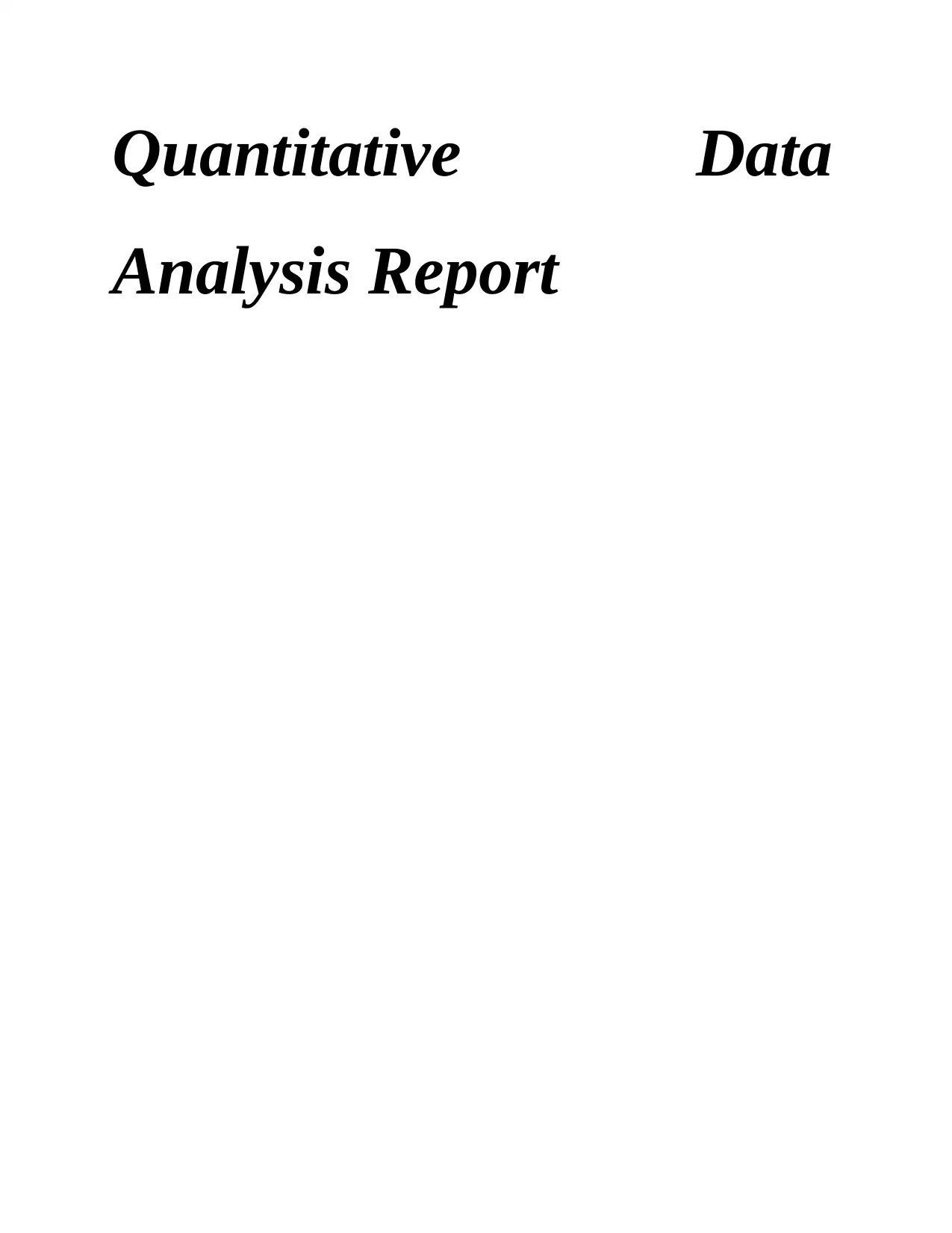
Quantitative Data
Analysis Report
Analysis Report
Secure Best Marks with AI Grader
Need help grading? Try our AI Grader for instant feedback on your assignments.
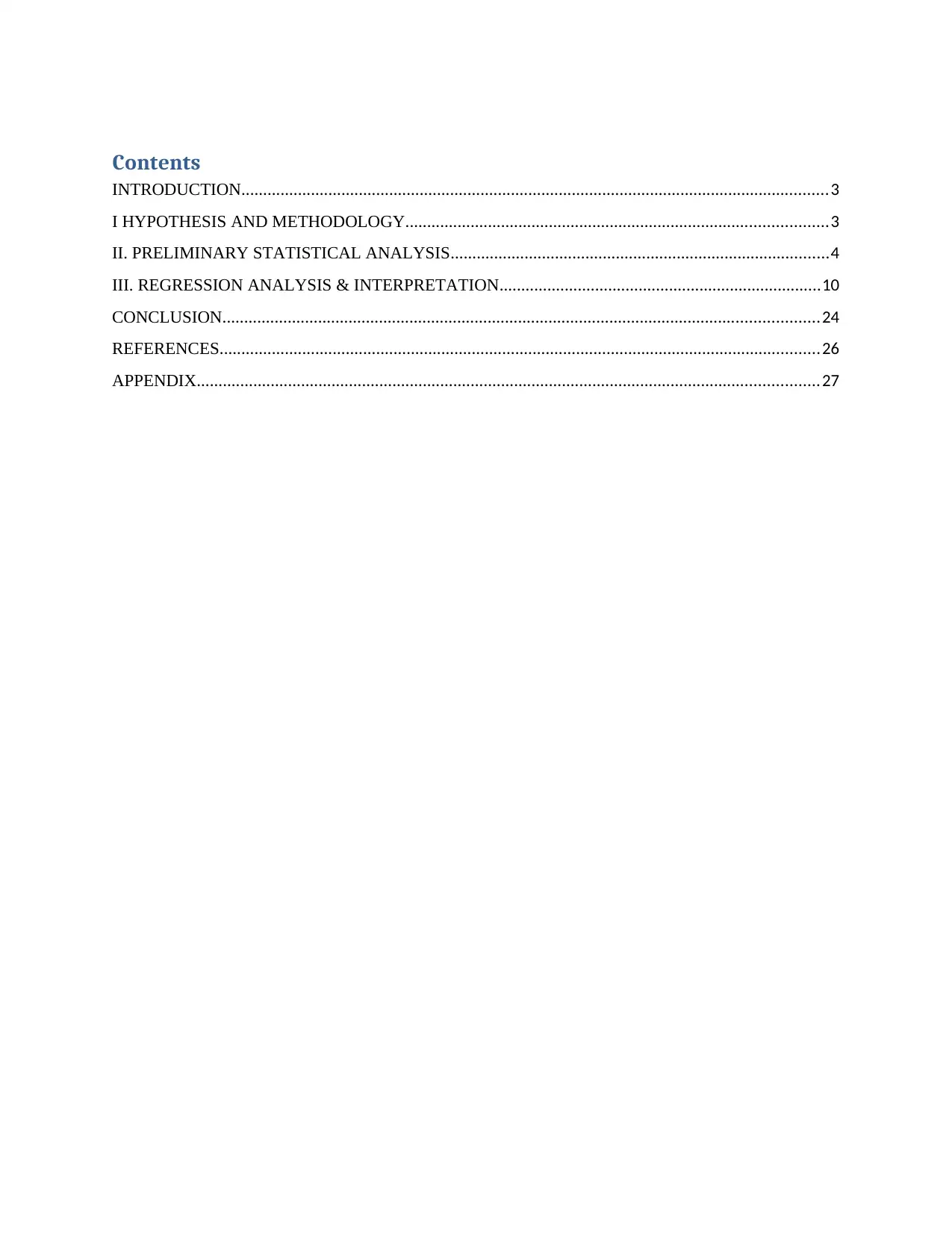
Contents
INTRODUCTION.......................................................................................................................................3
I HYPOTHESIS AND METHODOLOGY.................................................................................................3
II. PRELIMINARY STATISTICAL ANALYSIS.......................................................................................4
III. REGRESSION ANALYSIS & INTERPRETATION..........................................................................10
CONCLUSION.........................................................................................................................................24
REFERENCES..........................................................................................................................................26
APPENDIX...............................................................................................................................................27
INTRODUCTION.......................................................................................................................................3
I HYPOTHESIS AND METHODOLOGY.................................................................................................3
II. PRELIMINARY STATISTICAL ANALYSIS.......................................................................................4
III. REGRESSION ANALYSIS & INTERPRETATION..........................................................................10
CONCLUSION.........................................................................................................................................24
REFERENCES..........................................................................................................................................26
APPENDIX...............................................................................................................................................27
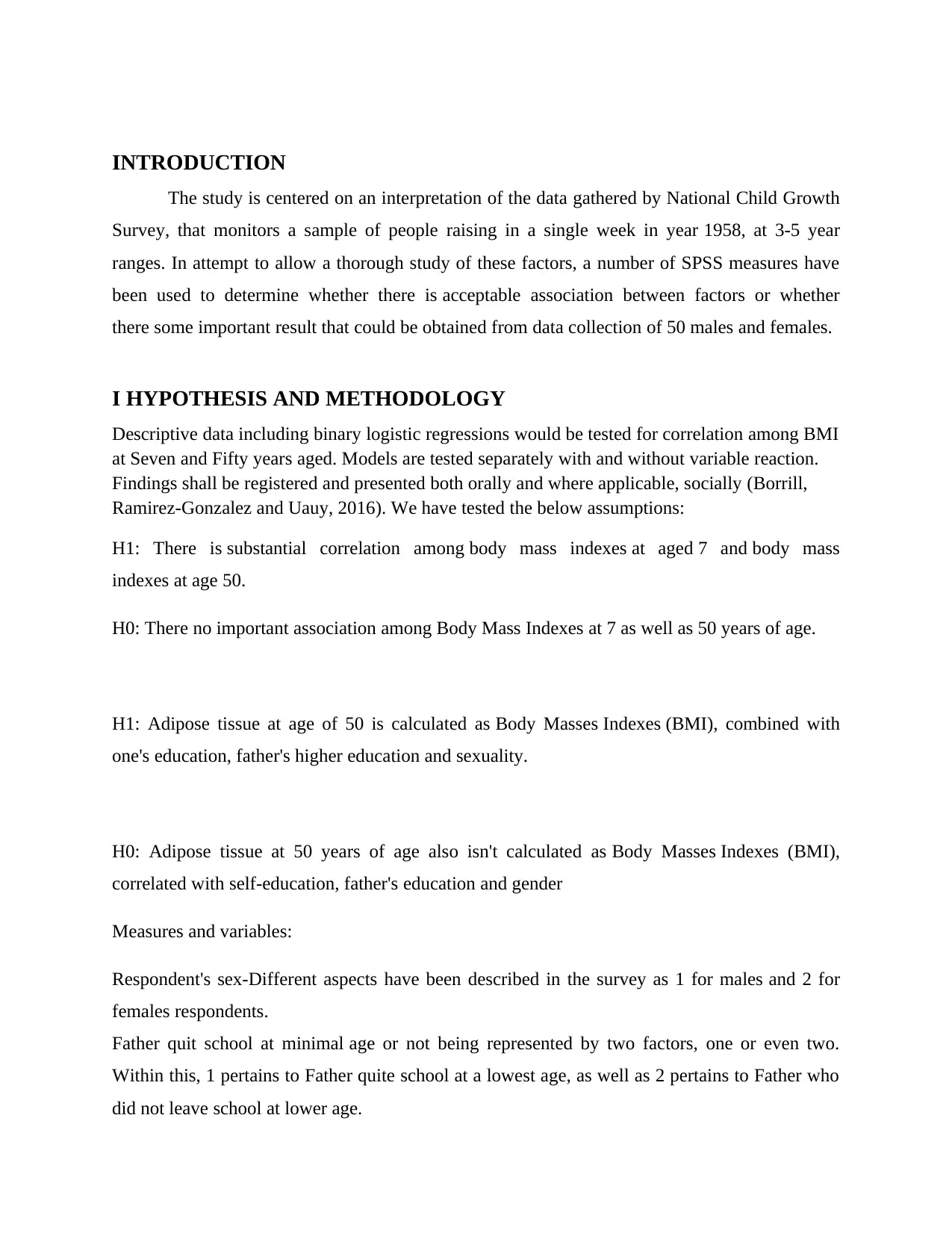
INTRODUCTION
The study is centered on an interpretation of the data gathered by National Child Growth
Survey, that monitors a sample of people raising in a single week in year 1958, at 3-5 year
ranges. In attempt to allow a thorough study of these factors, a number of SPSS measures have
been used to determine whether there is acceptable association between factors or whether
there some important result that could be obtained from data collection of 50 males and females.
I HYPOTHESIS AND METHODOLOGY
Descriptive data including binary logistic regressions would be tested for correlation among BMI
at Seven and Fifty years aged. Models are tested separately with and without variable reaction.
Findings shall be registered and presented both orally and where applicable, socially (Borrill,
Ramirez-Gonzalez and Uauy, 2016). We have tested the below assumptions:
H1: There is substantial correlation among body mass indexes at aged 7 and body mass
indexes at age 50.
H0: There no important association among Body Mass Indexes at 7 as well as 50 years of age.
H1: Adipose tissue at age of 50 is calculated as Body Masses Indexes (BMI), combined with
one's education, father's higher education and sexuality.
H0: Adipose tissue at 50 years of age also isn't calculated as Body Masses Indexes (BMI),
correlated with self-education, father's education and gender
Measures and variables:
Respondent's sex-Different aspects have been described in the survey as 1 for males and 2 for
females respondents.
Father quit school at minimal age or not being represented by two factors, one or even two.
Within this, 1 pertains to Father quite school at a lowest age, as well as 2 pertains to Father who
did not leave school at lower age.
The study is centered on an interpretation of the data gathered by National Child Growth
Survey, that monitors a sample of people raising in a single week in year 1958, at 3-5 year
ranges. In attempt to allow a thorough study of these factors, a number of SPSS measures have
been used to determine whether there is acceptable association between factors or whether
there some important result that could be obtained from data collection of 50 males and females.
I HYPOTHESIS AND METHODOLOGY
Descriptive data including binary logistic regressions would be tested for correlation among BMI
at Seven and Fifty years aged. Models are tested separately with and without variable reaction.
Findings shall be registered and presented both orally and where applicable, socially (Borrill,
Ramirez-Gonzalez and Uauy, 2016). We have tested the below assumptions:
H1: There is substantial correlation among body mass indexes at aged 7 and body mass
indexes at age 50.
H0: There no important association among Body Mass Indexes at 7 as well as 50 years of age.
H1: Adipose tissue at age of 50 is calculated as Body Masses Indexes (BMI), combined with
one's education, father's higher education and sexuality.
H0: Adipose tissue at 50 years of age also isn't calculated as Body Masses Indexes (BMI),
correlated with self-education, father's education and gender
Measures and variables:
Respondent's sex-Different aspects have been described in the survey as 1 for males and 2 for
females respondents.
Father quit school at minimal age or not being represented by two factors, one or even two.
Within this, 1 pertains to Father quite school at a lowest age, as well as 2 pertains to Father who
did not leave school at lower age.
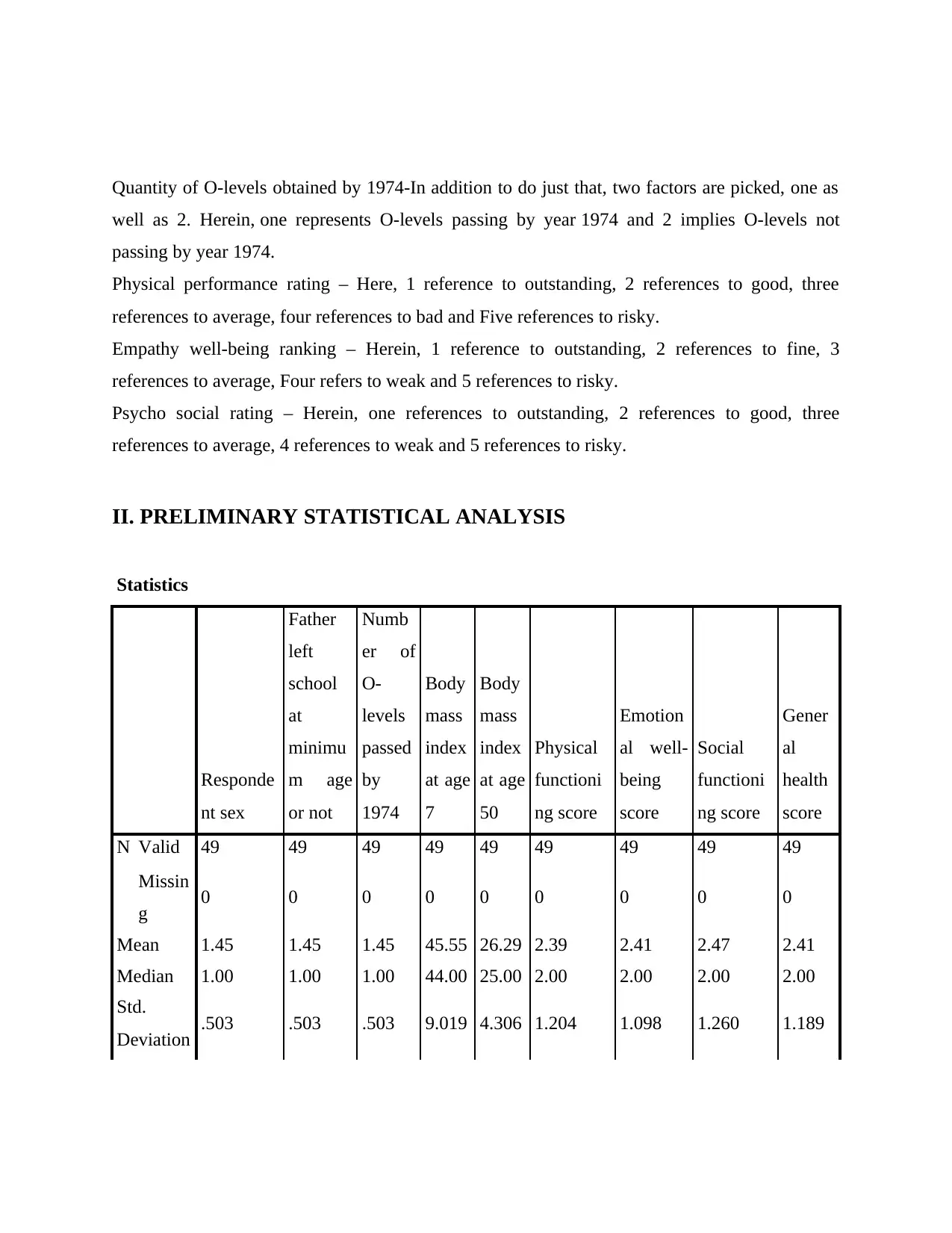
Quantity of O-levels obtained by 1974-In addition to do just that, two factors are picked, one as
well as 2. Herein, one represents O-levels passing by year 1974 and 2 implies O-levels not
passing by year 1974.
Physical performance rating – Here, 1 reference to outstanding, 2 references to good, three
references to average, four references to bad and Five references to risky.
Empathy well-being ranking – Herein, 1 reference to outstanding, 2 references to fine, 3
references to average, Four refers to weak and 5 references to risky.
Psycho social rating – Herein, one references to outstanding, 2 references to good, three
references to average, 4 references to weak and 5 references to risky.
II. PRELIMINARY STATISTICAL ANALYSIS
Statistics
Responde
nt sex
Father
left
school
at
minimu
m age
or not
Numb
er of
O-
levels
passed
by
1974
Body
mass
index
at age
7
Body
mass
index
at age
50
Physical
functioni
ng score
Emotion
al well-
being
score
Social
functioni
ng score
Gener
al
health
score
N Valid 49 49 49 49 49 49 49 49 49
Missin
g 0 0 0 0 0 0 0 0 0
Mean 1.45 1.45 1.45 45.55 26.29 2.39 2.41 2.47 2.41
Median 1.00 1.00 1.00 44.00 25.00 2.00 2.00 2.00 2.00
Std.
Deviation .503 .503 .503 9.019 4.306 1.204 1.098 1.260 1.189
well as 2. Herein, one represents O-levels passing by year 1974 and 2 implies O-levels not
passing by year 1974.
Physical performance rating – Here, 1 reference to outstanding, 2 references to good, three
references to average, four references to bad and Five references to risky.
Empathy well-being ranking – Herein, 1 reference to outstanding, 2 references to fine, 3
references to average, Four refers to weak and 5 references to risky.
Psycho social rating – Herein, one references to outstanding, 2 references to good, three
references to average, 4 references to weak and 5 references to risky.
II. PRELIMINARY STATISTICAL ANALYSIS
Statistics
Responde
nt sex
Father
left
school
at
minimu
m age
or not
Numb
er of
O-
levels
passed
by
1974
Body
mass
index
at age
7
Body
mass
index
at age
50
Physical
functioni
ng score
Emotion
al well-
being
score
Social
functioni
ng score
Gener
al
health
score
N Valid 49 49 49 49 49 49 49 49 49
Missin
g 0 0 0 0 0 0 0 0 0
Mean 1.45 1.45 1.45 45.55 26.29 2.39 2.41 2.47 2.41
Median 1.00 1.00 1.00 44.00 25.00 2.00 2.00 2.00 2.00
Std.
Deviation .503 .503 .503 9.019 4.306 1.204 1.098 1.260 1.189
Secure Best Marks with AI Grader
Need help grading? Try our AI Grader for instant feedback on your assignments.
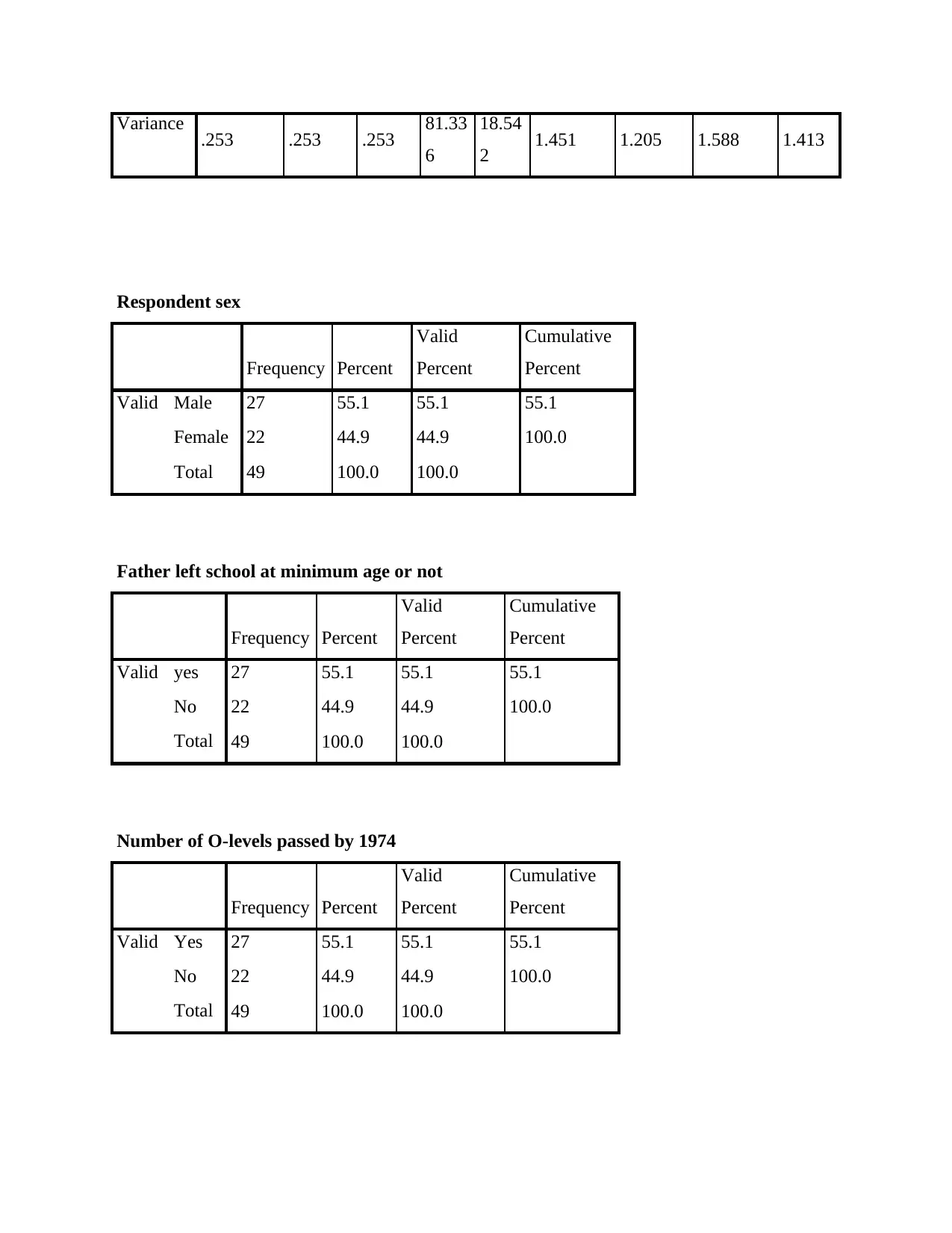
Variance .253 .253 .253 81.33
6
18.54
2 1.451 1.205 1.588 1.413
Respondent sex
Frequency Percent
Valid
Percent
Cumulative
Percent
Valid Male 27 55.1 55.1 55.1
Female 22 44.9 44.9 100.0
Total 49 100.0 100.0
Father left school at minimum age or not
Frequency Percent
Valid
Percent
Cumulative
Percent
Valid yes 27 55.1 55.1 55.1
No 22 44.9 44.9 100.0
Total 49 100.0 100.0
Number of O-levels passed by 1974
Frequency Percent
Valid
Percent
Cumulative
Percent
Valid Yes 27 55.1 55.1 55.1
No 22 44.9 44.9 100.0
Total 49 100.0 100.0
6
18.54
2 1.451 1.205 1.588 1.413
Respondent sex
Frequency Percent
Valid
Percent
Cumulative
Percent
Valid Male 27 55.1 55.1 55.1
Female 22 44.9 44.9 100.0
Total 49 100.0 100.0
Father left school at minimum age or not
Frequency Percent
Valid
Percent
Cumulative
Percent
Valid yes 27 55.1 55.1 55.1
No 22 44.9 44.9 100.0
Total 49 100.0 100.0
Number of O-levels passed by 1974
Frequency Percent
Valid
Percent
Cumulative
Percent
Valid Yes 27 55.1 55.1 55.1
No 22 44.9 44.9 100.0
Total 49 100.0 100.0
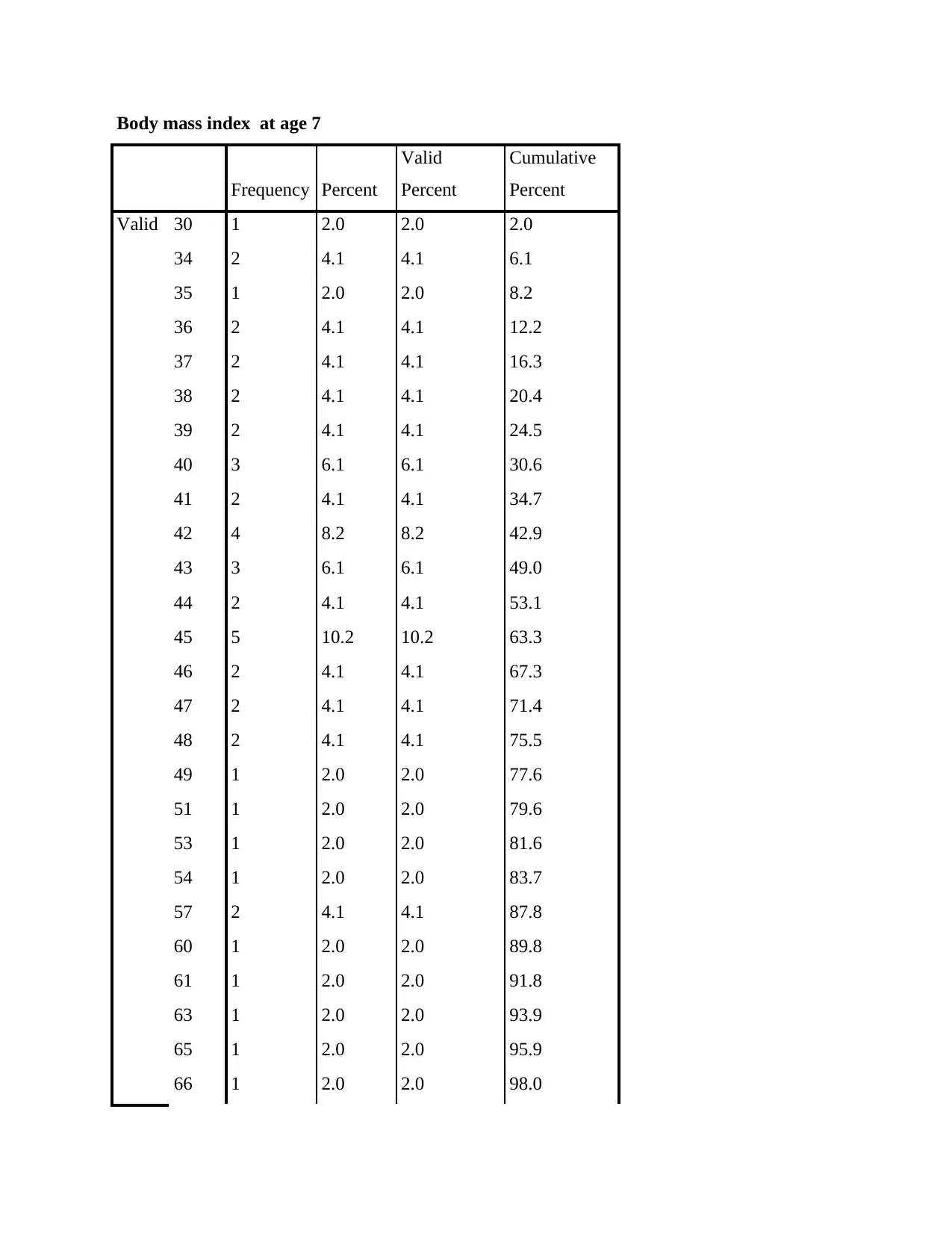
Body mass index at age 7
Frequency Percent
Valid
Percent
Cumulative
Percent
Valid 30 1 2.0 2.0 2.0
34 2 4.1 4.1 6.1
35 1 2.0 2.0 8.2
36 2 4.1 4.1 12.2
37 2 4.1 4.1 16.3
38 2 4.1 4.1 20.4
39 2 4.1 4.1 24.5
40 3 6.1 6.1 30.6
41 2 4.1 4.1 34.7
42 4 8.2 8.2 42.9
43 3 6.1 6.1 49.0
44 2 4.1 4.1 53.1
45 5 10.2 10.2 63.3
46 2 4.1 4.1 67.3
47 2 4.1 4.1 71.4
48 2 4.1 4.1 75.5
49 1 2.0 2.0 77.6
51 1 2.0 2.0 79.6
53 1 2.0 2.0 81.6
54 1 2.0 2.0 83.7
57 2 4.1 4.1 87.8
60 1 2.0 2.0 89.8
61 1 2.0 2.0 91.8
63 1 2.0 2.0 93.9
65 1 2.0 2.0 95.9
66 1 2.0 2.0 98.0
Frequency Percent
Valid
Percent
Cumulative
Percent
Valid 30 1 2.0 2.0 2.0
34 2 4.1 4.1 6.1
35 1 2.0 2.0 8.2
36 2 4.1 4.1 12.2
37 2 4.1 4.1 16.3
38 2 4.1 4.1 20.4
39 2 4.1 4.1 24.5
40 3 6.1 6.1 30.6
41 2 4.1 4.1 34.7
42 4 8.2 8.2 42.9
43 3 6.1 6.1 49.0
44 2 4.1 4.1 53.1
45 5 10.2 10.2 63.3
46 2 4.1 4.1 67.3
47 2 4.1 4.1 71.4
48 2 4.1 4.1 75.5
49 1 2.0 2.0 77.6
51 1 2.0 2.0 79.6
53 1 2.0 2.0 81.6
54 1 2.0 2.0 83.7
57 2 4.1 4.1 87.8
60 1 2.0 2.0 89.8
61 1 2.0 2.0 91.8
63 1 2.0 2.0 93.9
65 1 2.0 2.0 95.9
66 1 2.0 2.0 98.0
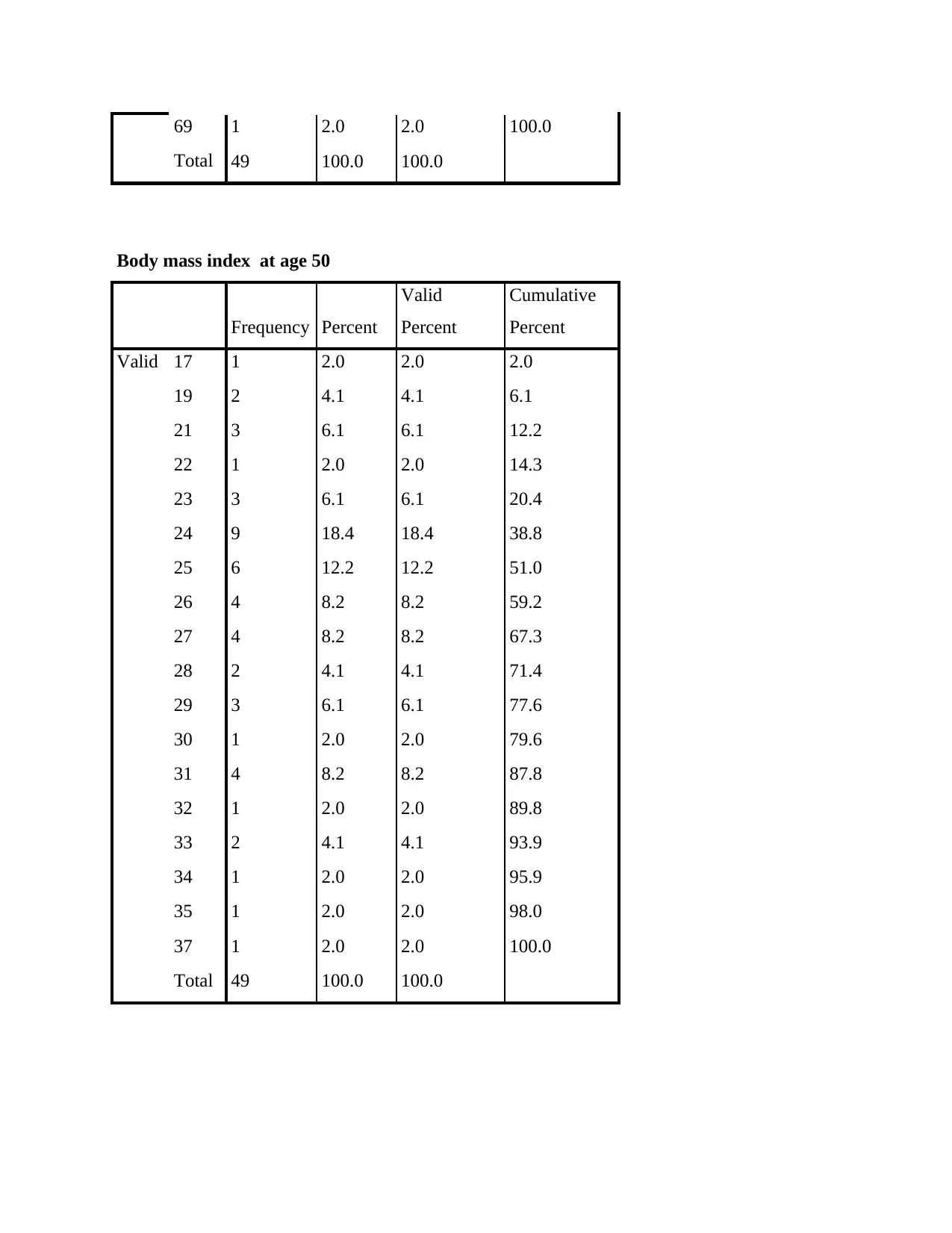
69 1 2.0 2.0 100.0
Total 49 100.0 100.0
Body mass index at age 50
Frequency Percent
Valid
Percent
Cumulative
Percent
Valid 17 1 2.0 2.0 2.0
19 2 4.1 4.1 6.1
21 3 6.1 6.1 12.2
22 1 2.0 2.0 14.3
23 3 6.1 6.1 20.4
24 9 18.4 18.4 38.8
25 6 12.2 12.2 51.0
26 4 8.2 8.2 59.2
27 4 8.2 8.2 67.3
28 2 4.1 4.1 71.4
29 3 6.1 6.1 77.6
30 1 2.0 2.0 79.6
31 4 8.2 8.2 87.8
32 1 2.0 2.0 89.8
33 2 4.1 4.1 93.9
34 1 2.0 2.0 95.9
35 1 2.0 2.0 98.0
37 1 2.0 2.0 100.0
Total 49 100.0 100.0
Total 49 100.0 100.0
Body mass index at age 50
Frequency Percent
Valid
Percent
Cumulative
Percent
Valid 17 1 2.0 2.0 2.0
19 2 4.1 4.1 6.1
21 3 6.1 6.1 12.2
22 1 2.0 2.0 14.3
23 3 6.1 6.1 20.4
24 9 18.4 18.4 38.8
25 6 12.2 12.2 51.0
26 4 8.2 8.2 59.2
27 4 8.2 8.2 67.3
28 2 4.1 4.1 71.4
29 3 6.1 6.1 77.6
30 1 2.0 2.0 79.6
31 4 8.2 8.2 87.8
32 1 2.0 2.0 89.8
33 2 4.1 4.1 93.9
34 1 2.0 2.0 95.9
35 1 2.0 2.0 98.0
37 1 2.0 2.0 100.0
Total 49 100.0 100.0
Paraphrase This Document
Need a fresh take? Get an instant paraphrase of this document with our AI Paraphraser
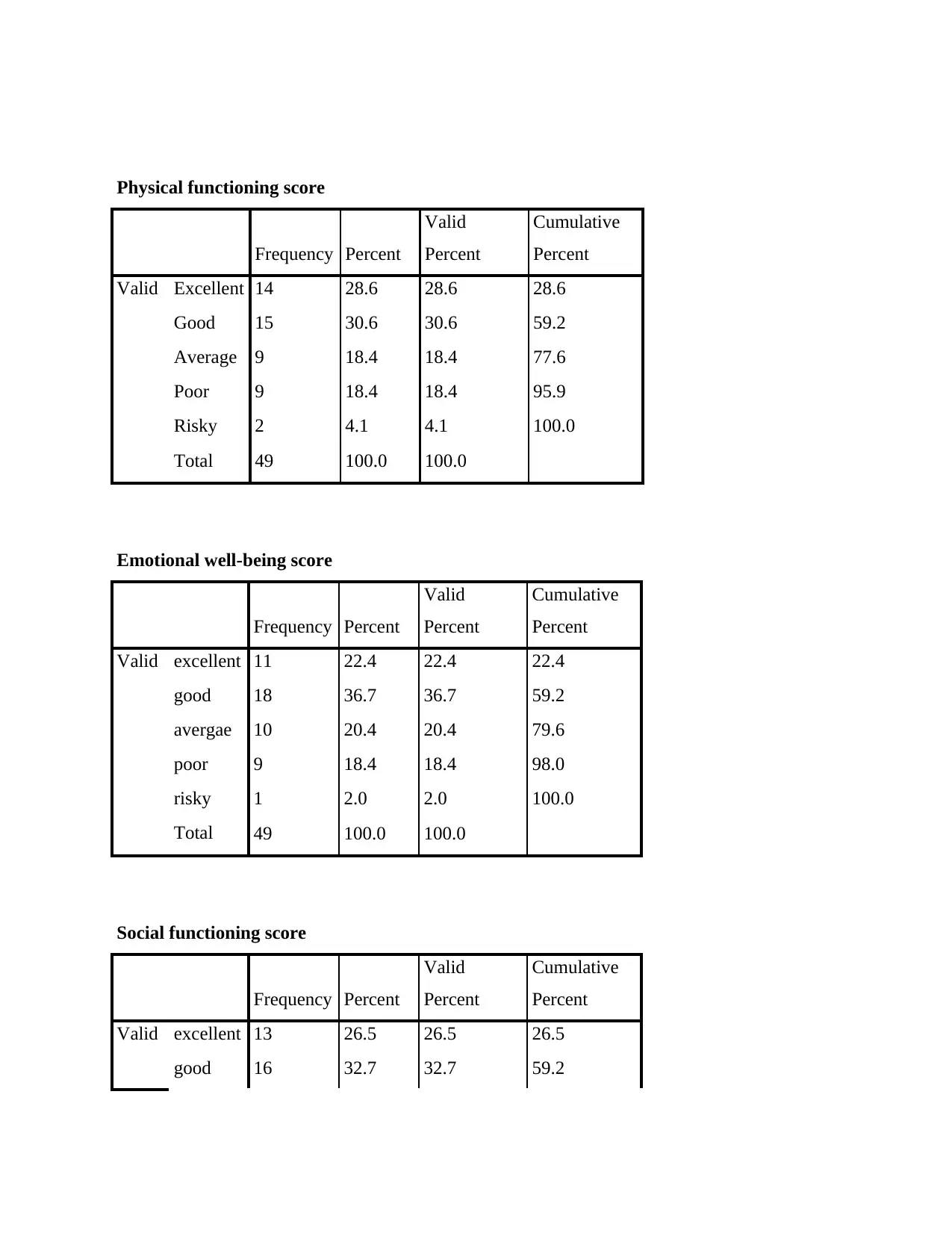
Physical functioning score
Frequency Percent
Valid
Percent
Cumulative
Percent
Valid Excellent 14 28.6 28.6 28.6
Good 15 30.6 30.6 59.2
Average 9 18.4 18.4 77.6
Poor 9 18.4 18.4 95.9
Risky 2 4.1 4.1 100.0
Total 49 100.0 100.0
Emotional well-being score
Frequency Percent
Valid
Percent
Cumulative
Percent
Valid excellent 11 22.4 22.4 22.4
good 18 36.7 36.7 59.2
avergae 10 20.4 20.4 79.6
poor 9 18.4 18.4 98.0
risky 1 2.0 2.0 100.0
Total 49 100.0 100.0
Social functioning score
Frequency Percent
Valid
Percent
Cumulative
Percent
Valid excellent 13 26.5 26.5 26.5
good 16 32.7 32.7 59.2
Frequency Percent
Valid
Percent
Cumulative
Percent
Valid Excellent 14 28.6 28.6 28.6
Good 15 30.6 30.6 59.2
Average 9 18.4 18.4 77.6
Poor 9 18.4 18.4 95.9
Risky 2 4.1 4.1 100.0
Total 49 100.0 100.0
Emotional well-being score
Frequency Percent
Valid
Percent
Cumulative
Percent
Valid excellent 11 22.4 22.4 22.4
good 18 36.7 36.7 59.2
avergae 10 20.4 20.4 79.6
poor 9 18.4 18.4 98.0
risky 1 2.0 2.0 100.0
Total 49 100.0 100.0
Social functioning score
Frequency Percent
Valid
Percent
Cumulative
Percent
Valid excellent 13 26.5 26.5 26.5
good 16 32.7 32.7 59.2
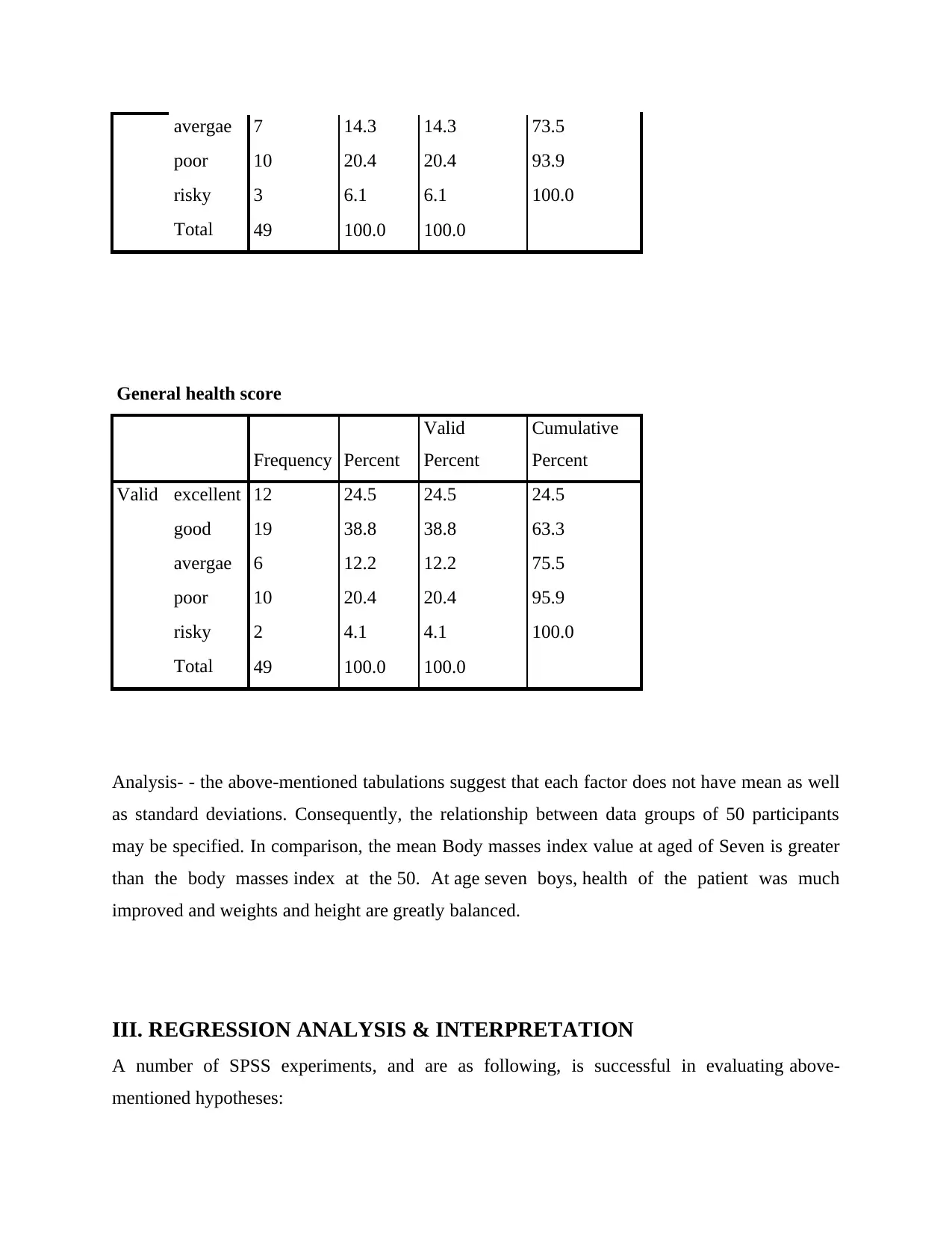
avergae 7 14.3 14.3 73.5
poor 10 20.4 20.4 93.9
risky 3 6.1 6.1 100.0
Total 49 100.0 100.0
General health score
Frequency Percent
Valid
Percent
Cumulative
Percent
Valid excellent 12 24.5 24.5 24.5
good 19 38.8 38.8 63.3
avergae 6 12.2 12.2 75.5
poor 10 20.4 20.4 95.9
risky 2 4.1 4.1 100.0
Total 49 100.0 100.0
Analysis- - the above-mentioned tabulations suggest that each factor does not have mean as well
as standard deviations. Consequently, the relationship between data groups of 50 participants
may be specified. In comparison, the mean Body masses index value at aged of Seven is greater
than the body masses index at the 50. At age seven boys, health of the patient was much
improved and weights and height are greatly balanced.
III. REGRESSION ANALYSIS & INTERPRETATION
A number of SPSS experiments, and are as following, is successful in evaluating above-
mentioned hypotheses:
poor 10 20.4 20.4 93.9
risky 3 6.1 6.1 100.0
Total 49 100.0 100.0
General health score
Frequency Percent
Valid
Percent
Cumulative
Percent
Valid excellent 12 24.5 24.5 24.5
good 19 38.8 38.8 63.3
avergae 6 12.2 12.2 75.5
poor 10 20.4 20.4 95.9
risky 2 4.1 4.1 100.0
Total 49 100.0 100.0
Analysis- - the above-mentioned tabulations suggest that each factor does not have mean as well
as standard deviations. Consequently, the relationship between data groups of 50 participants
may be specified. In comparison, the mean Body masses index value at aged of Seven is greater
than the body masses index at the 50. At age seven boys, health of the patient was much
improved and weights and height are greatly balanced.
III. REGRESSION ANALYSIS & INTERPRETATION
A number of SPSS experiments, and are as following, is successful in evaluating above-
mentioned hypotheses:
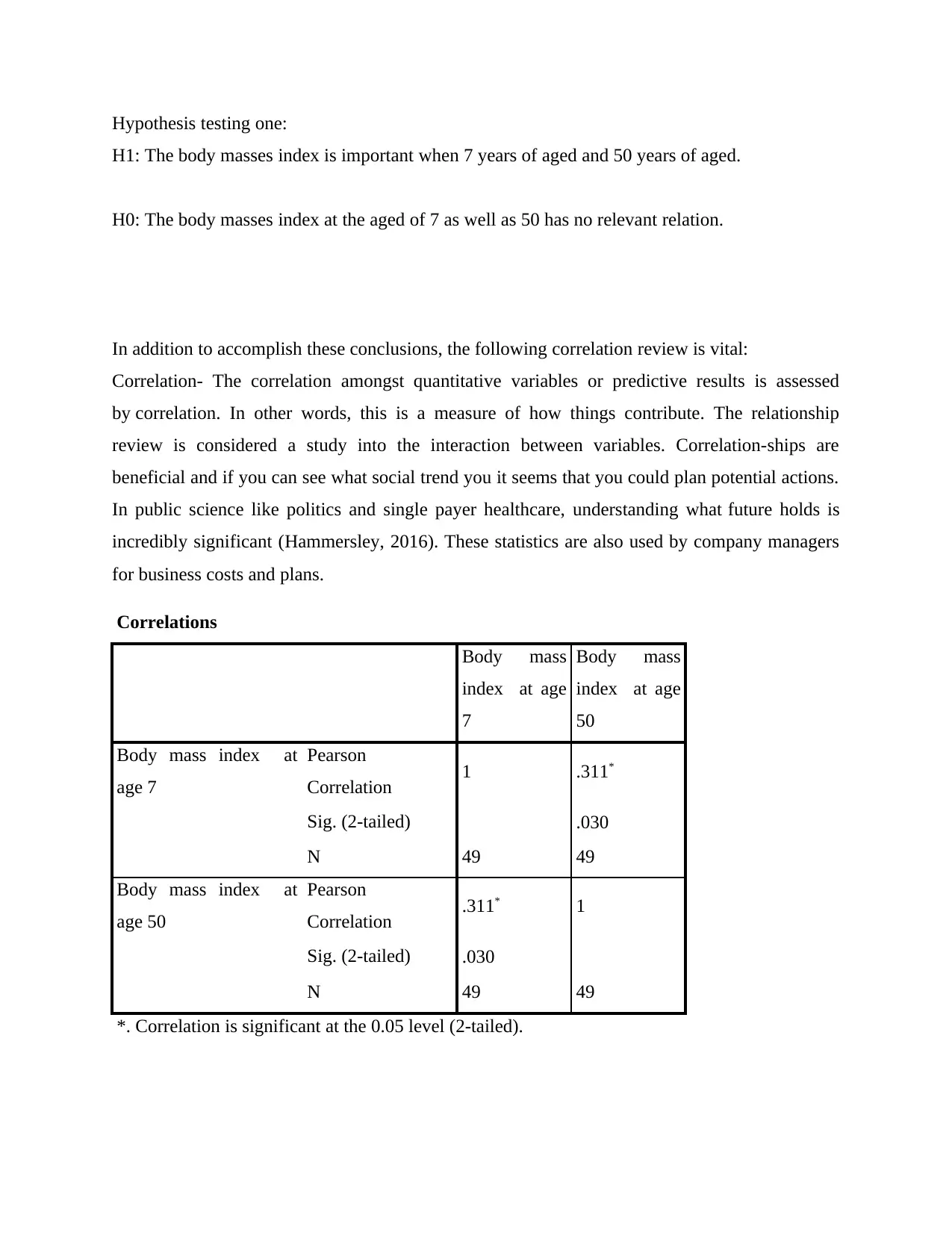
Hypothesis testing one:
H1: The body masses index is important when 7 years of aged and 50 years of aged.
H0: The body masses index at the aged of 7 as well as 50 has no relevant relation.
In addition to accomplish these conclusions, the following correlation review is vital:
Correlation- The correlation amongst quantitative variables or predictive results is assessed
by correlation. In other words, this is a measure of how things contribute. The relationship
review is considered a study into the interaction between variables. Correlation-ships are
beneficial and if you can see what social trend you it seems that you could plan potential actions.
In public science like politics and single payer healthcare, understanding what future holds is
incredibly significant (Hammersley, 2016). These statistics are also used by company managers
for business costs and plans.
Correlations
Body mass
index at age
7
Body mass
index at age
50
Body mass index at
age 7
Pearson
Correlation 1 .311*
Sig. (2-tailed) .030
N 49 49
Body mass index at
age 50
Pearson
Correlation .311* 1
Sig. (2-tailed) .030
N 49 49
*. Correlation is significant at the 0.05 level (2-tailed).
H1: The body masses index is important when 7 years of aged and 50 years of aged.
H0: The body masses index at the aged of 7 as well as 50 has no relevant relation.
In addition to accomplish these conclusions, the following correlation review is vital:
Correlation- The correlation amongst quantitative variables or predictive results is assessed
by correlation. In other words, this is a measure of how things contribute. The relationship
review is considered a study into the interaction between variables. Correlation-ships are
beneficial and if you can see what social trend you it seems that you could plan potential actions.
In public science like politics and single payer healthcare, understanding what future holds is
incredibly significant (Hammersley, 2016). These statistics are also used by company managers
for business costs and plans.
Correlations
Body mass
index at age
7
Body mass
index at age
50
Body mass index at
age 7
Pearson
Correlation 1 .311*
Sig. (2-tailed) .030
N 49 49
Body mass index at
age 50
Pearson
Correlation .311* 1
Sig. (2-tailed) .030
N 49 49
*. Correlation is significant at the 0.05 level (2-tailed).
Secure Best Marks with AI Grader
Need help grading? Try our AI Grader for instant feedback on your assignments.
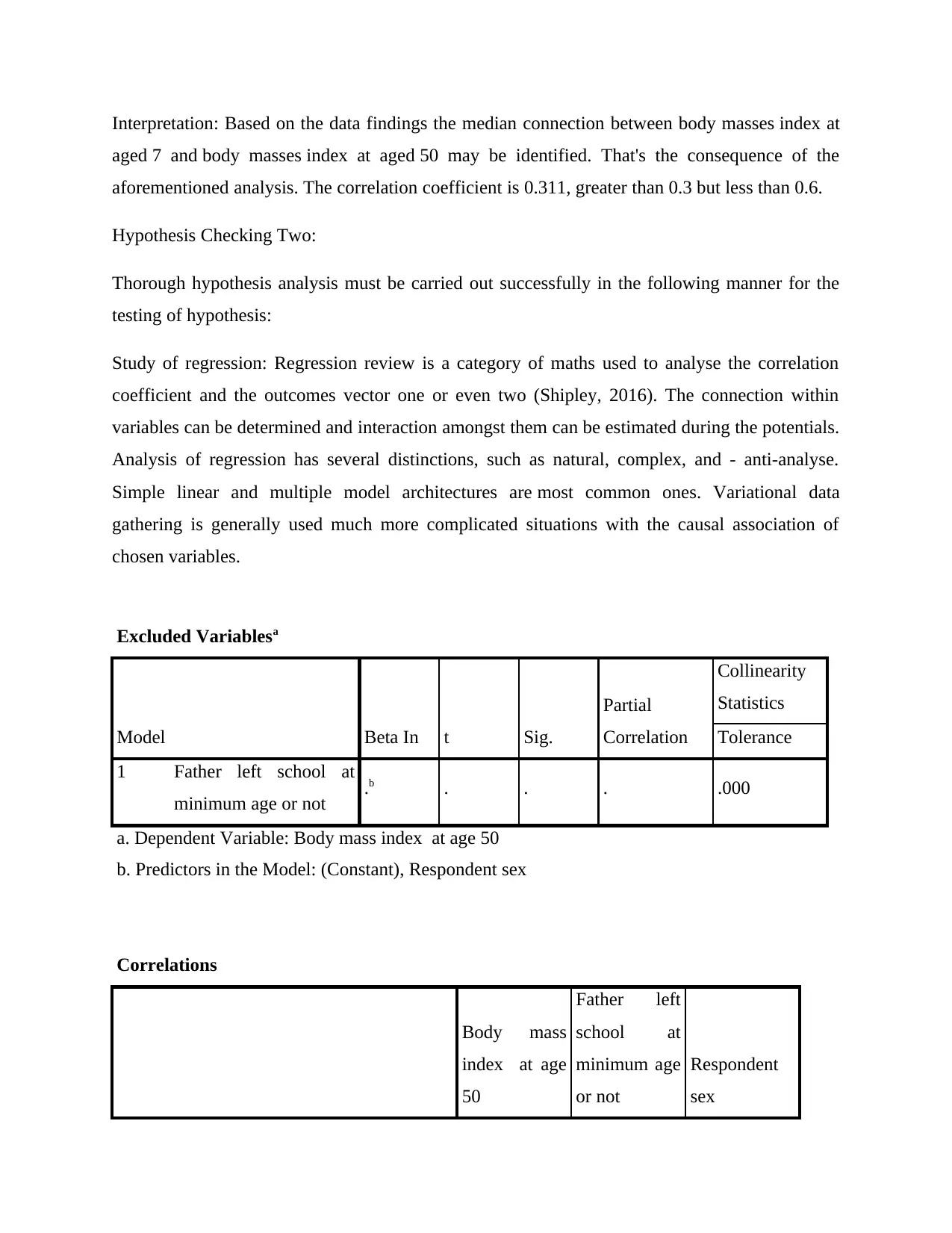
Interpretation: Based on the data findings the median connection between body masses index at
aged 7 and body masses index at aged 50 may be identified. That's the consequence of the
aforementioned analysis. The correlation coefficient is 0.311, greater than 0.3 but less than 0.6.
Hypothesis Checking Two:
Thorough hypothesis analysis must be carried out successfully in the following manner for the
testing of hypothesis:
Study of regression: Regression review is a category of maths used to analyse the correlation
coefficient and the outcomes vector one or even two (Shipley, 2016). The connection within
variables can be determined and interaction amongst them can be estimated during the potentials.
Analysis of regression has several distinctions, such as natural, complex, and - anti-analyse.
Simple linear and multiple model architectures are most common ones. Variational data
gathering is generally used much more complicated situations with the causal association of
chosen variables.
Excluded Variablesa
Model Beta In t Sig.
Partial
Correlation
Collinearity
Statistics
Tolerance
1 Father left school at
minimum age or not .b . . . .000
a. Dependent Variable: Body mass index at age 50
b. Predictors in the Model: (Constant), Respondent sex
Correlations
Body mass
index at age
50
Father left
school at
minimum age
or not
Respondent
sex
aged 7 and body masses index at aged 50 may be identified. That's the consequence of the
aforementioned analysis. The correlation coefficient is 0.311, greater than 0.3 but less than 0.6.
Hypothesis Checking Two:
Thorough hypothesis analysis must be carried out successfully in the following manner for the
testing of hypothesis:
Study of regression: Regression review is a category of maths used to analyse the correlation
coefficient and the outcomes vector one or even two (Shipley, 2016). The connection within
variables can be determined and interaction amongst them can be estimated during the potentials.
Analysis of regression has several distinctions, such as natural, complex, and - anti-analyse.
Simple linear and multiple model architectures are most common ones. Variational data
gathering is generally used much more complicated situations with the causal association of
chosen variables.
Excluded Variablesa
Model Beta In t Sig.
Partial
Correlation
Collinearity
Statistics
Tolerance
1 Father left school at
minimum age or not .b . . . .000
a. Dependent Variable: Body mass index at age 50
b. Predictors in the Model: (Constant), Respondent sex
Correlations
Body mass
index at age
50
Father left
school at
minimum age
or not
Respondent
sex
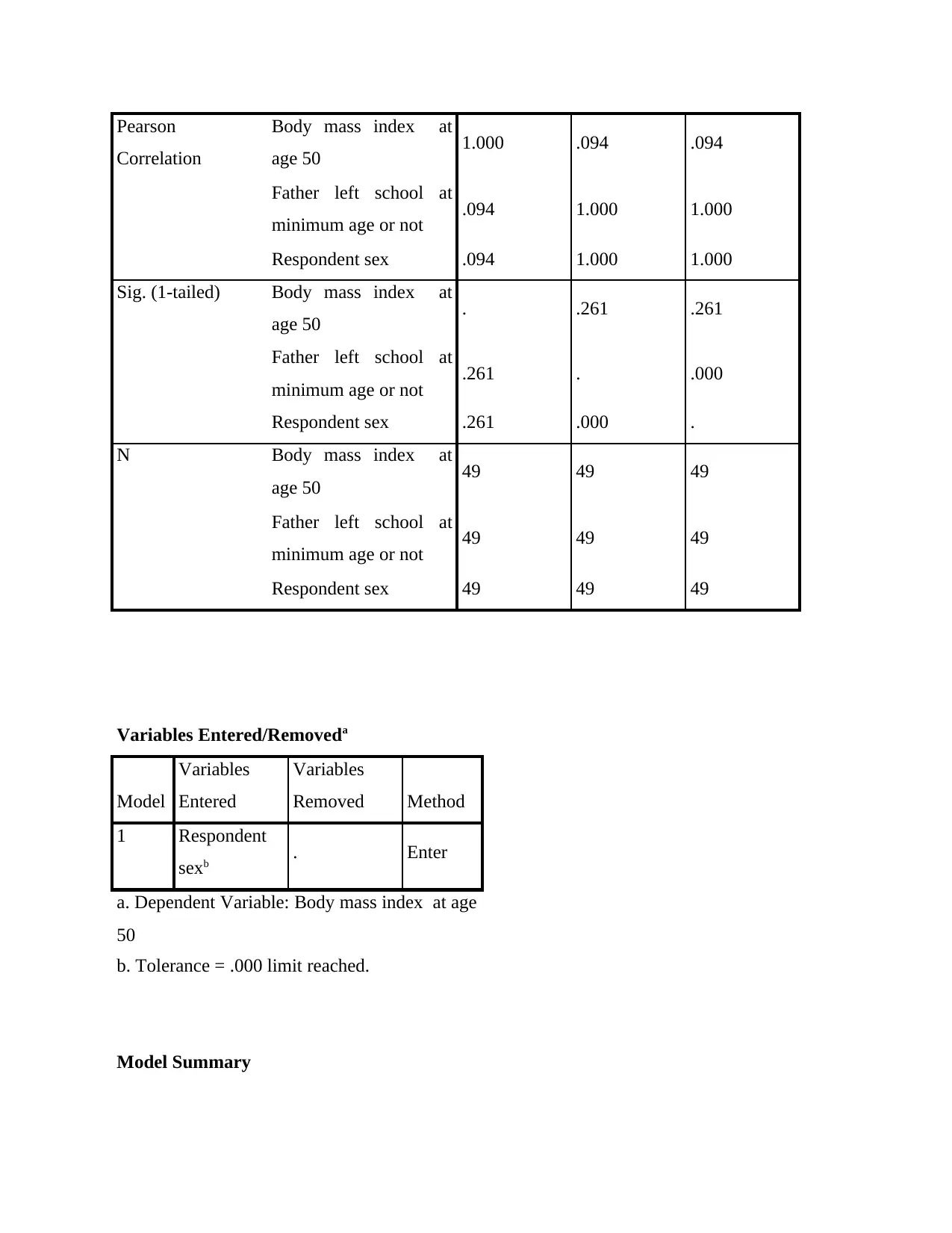
Pearson
Correlation
Body mass index at
age 50 1.000 .094 .094
Father left school at
minimum age or not .094 1.000 1.000
Respondent sex .094 1.000 1.000
Sig. (1-tailed) Body mass index at
age 50 . .261 .261
Father left school at
minimum age or not .261 . .000
Respondent sex .261 .000 .
N Body mass index at
age 50 49 49 49
Father left school at
minimum age or not 49 49 49
Respondent sex 49 49 49
Variables Entered/Removeda
Model
Variables
Entered
Variables
Removed Method
1 Respondent
sexb . Enter
a. Dependent Variable: Body mass index at age
50
b. Tolerance = .000 limit reached.
Model Summary
Correlation
Body mass index at
age 50 1.000 .094 .094
Father left school at
minimum age or not .094 1.000 1.000
Respondent sex .094 1.000 1.000
Sig. (1-tailed) Body mass index at
age 50 . .261 .261
Father left school at
minimum age or not .261 . .000
Respondent sex .261 .000 .
N Body mass index at
age 50 49 49 49
Father left school at
minimum age or not 49 49 49
Respondent sex 49 49 49
Variables Entered/Removeda
Model
Variables
Entered
Variables
Removed Method
1 Respondent
sexb . Enter
a. Dependent Variable: Body mass index at age
50
b. Tolerance = .000 limit reached.
Model Summary
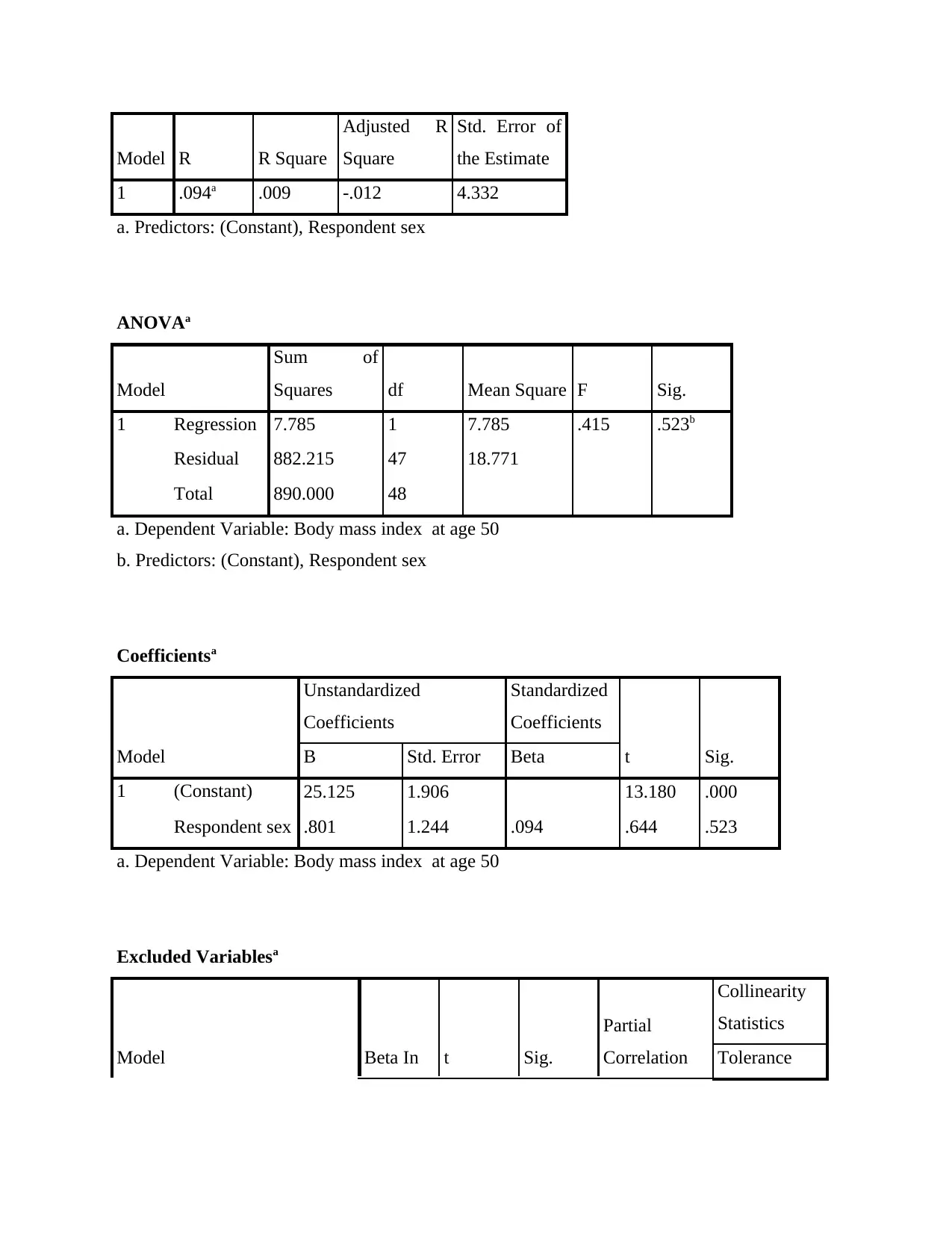
Model R R Square
Adjusted R
Square
Std. Error of
the Estimate
1 .094a .009 -.012 4.332
a. Predictors: (Constant), Respondent sex
ANOVAa
Model
Sum of
Squares df Mean Square F Sig.
1 Regression 7.785 1 7.785 .415 .523b
Residual 882.215 47 18.771
Total 890.000 48
a. Dependent Variable: Body mass index at age 50
b. Predictors: (Constant), Respondent sex
Coefficientsa
Model
Unstandardized
Coefficients
Standardized
Coefficients
t Sig.B Std. Error Beta
1 (Constant) 25.125 1.906 13.180 .000
Respondent sex .801 1.244 .094 .644 .523
a. Dependent Variable: Body mass index at age 50
Excluded Variablesa
Model Beta In t Sig.
Partial
Correlation
Collinearity
Statistics
Tolerance
Adjusted R
Square
Std. Error of
the Estimate
1 .094a .009 -.012 4.332
a. Predictors: (Constant), Respondent sex
ANOVAa
Model
Sum of
Squares df Mean Square F Sig.
1 Regression 7.785 1 7.785 .415 .523b
Residual 882.215 47 18.771
Total 890.000 48
a. Dependent Variable: Body mass index at age 50
b. Predictors: (Constant), Respondent sex
Coefficientsa
Model
Unstandardized
Coefficients
Standardized
Coefficients
t Sig.B Std. Error Beta
1 (Constant) 25.125 1.906 13.180 .000
Respondent sex .801 1.244 .094 .644 .523
a. Dependent Variable: Body mass index at age 50
Excluded Variablesa
Model Beta In t Sig.
Partial
Correlation
Collinearity
Statistics
Tolerance
Paraphrase This Document
Need a fresh take? Get an instant paraphrase of this document with our AI Paraphraser
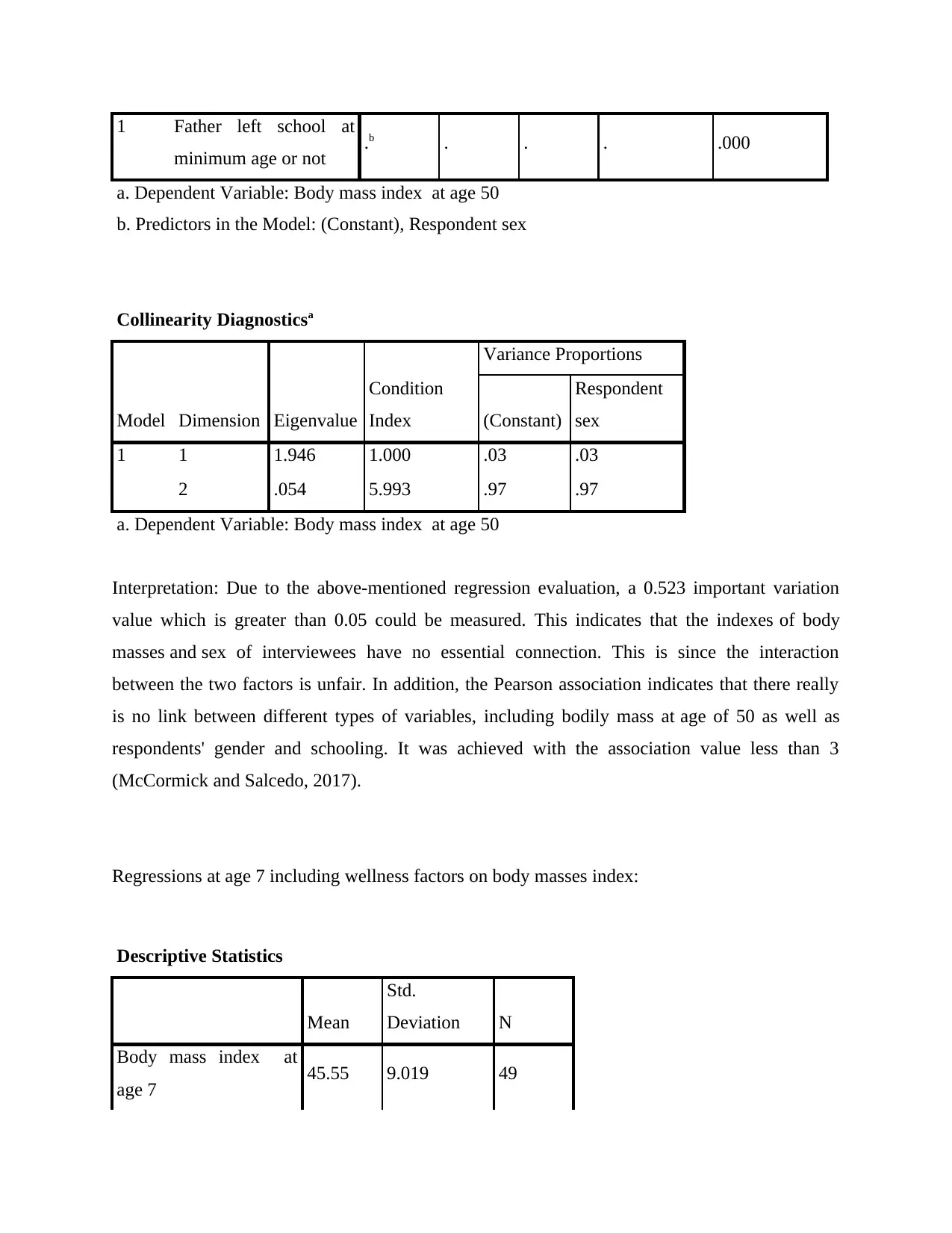
1 Father left school at
minimum age or not .b . . . .000
a. Dependent Variable: Body mass index at age 50
b. Predictors in the Model: (Constant), Respondent sex
Collinearity Diagnosticsa
Model Dimension Eigenvalue
Condition
Index
Variance Proportions
(Constant)
Respondent
sex
1 1 1.946 1.000 .03 .03
2 .054 5.993 .97 .97
a. Dependent Variable: Body mass index at age 50
Interpretation: Due to the above-mentioned regression evaluation, a 0.523 important variation
value which is greater than 0.05 could be measured. This indicates that the indexes of body
masses and sex of interviewees have no essential connection. This is since the interaction
between the two factors is unfair. In addition, the Pearson association indicates that there really
is no link between different types of variables, including bodily mass at age of 50 as well as
respondents' gender and schooling. It was achieved with the association value less than 3
(McCormick and Salcedo, 2017).
Regressions at age 7 including wellness factors on body masses index:
Descriptive Statistics
Mean
Std.
Deviation N
Body mass index at
age 7 45.55 9.019 49
minimum age or not .b . . . .000
a. Dependent Variable: Body mass index at age 50
b. Predictors in the Model: (Constant), Respondent sex
Collinearity Diagnosticsa
Model Dimension Eigenvalue
Condition
Index
Variance Proportions
(Constant)
Respondent
sex
1 1 1.946 1.000 .03 .03
2 .054 5.993 .97 .97
a. Dependent Variable: Body mass index at age 50
Interpretation: Due to the above-mentioned regression evaluation, a 0.523 important variation
value which is greater than 0.05 could be measured. This indicates that the indexes of body
masses and sex of interviewees have no essential connection. This is since the interaction
between the two factors is unfair. In addition, the Pearson association indicates that there really
is no link between different types of variables, including bodily mass at age of 50 as well as
respondents' gender and schooling. It was achieved with the association value less than 3
(McCormick and Salcedo, 2017).
Regressions at age 7 including wellness factors on body masses index:
Descriptive Statistics
Mean
Std.
Deviation N
Body mass index at
age 7 45.55 9.019 49
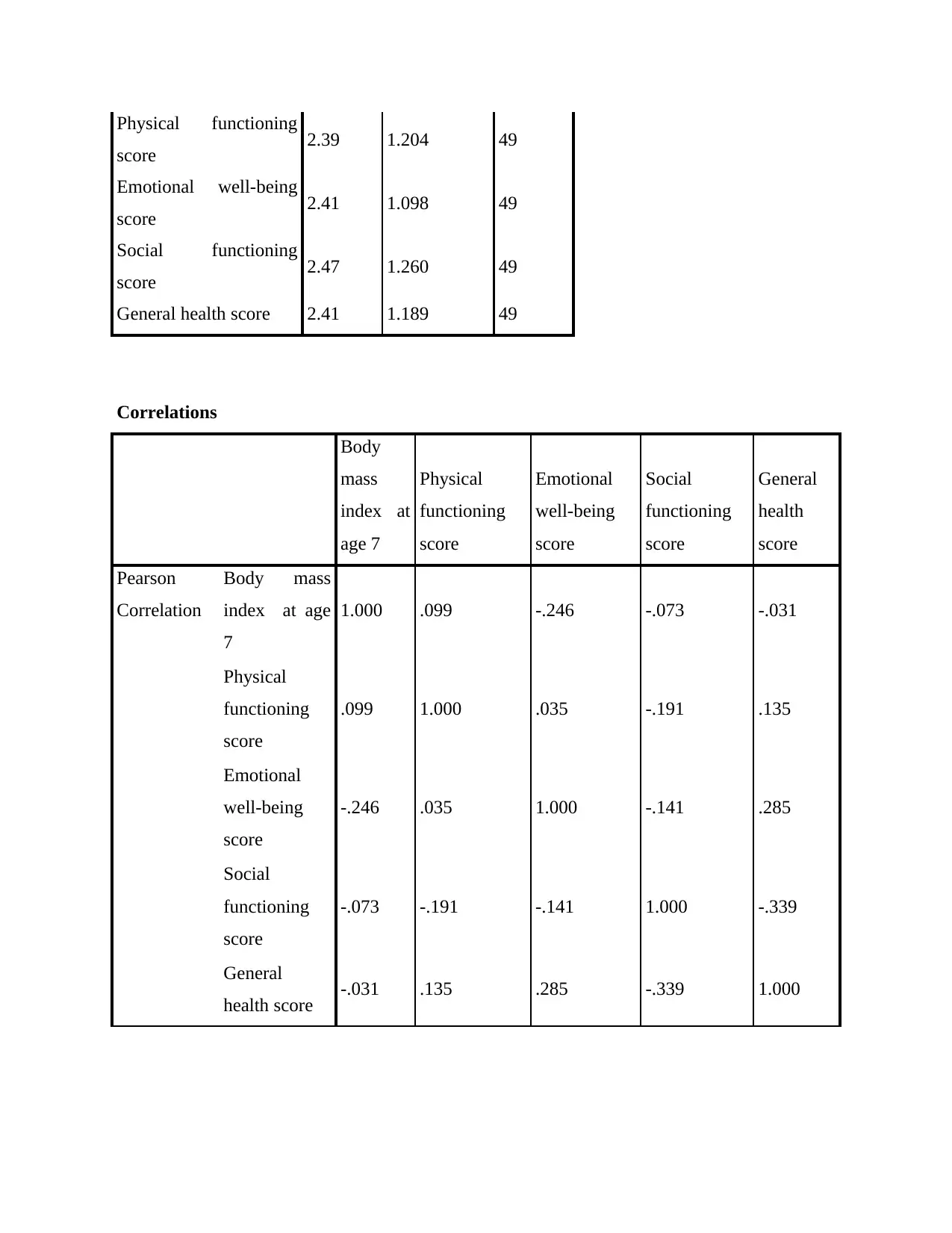
Physical functioning
score 2.39 1.204 49
Emotional well-being
score 2.41 1.098 49
Social functioning
score 2.47 1.260 49
General health score 2.41 1.189 49
Correlations
Body
mass
index at
age 7
Physical
functioning
score
Emotional
well-being
score
Social
functioning
score
General
health
score
Pearson
Correlation
Body mass
index at age
7
1.000 .099 -.246 -.073 -.031
Physical
functioning
score
.099 1.000 .035 -.191 .135
Emotional
well-being
score
-.246 .035 1.000 -.141 .285
Social
functioning
score
-.073 -.191 -.141 1.000 -.339
General
health score -.031 .135 .285 -.339 1.000
score 2.39 1.204 49
Emotional well-being
score 2.41 1.098 49
Social functioning
score 2.47 1.260 49
General health score 2.41 1.189 49
Correlations
Body
mass
index at
age 7
Physical
functioning
score
Emotional
well-being
score
Social
functioning
score
General
health
score
Pearson
Correlation
Body mass
index at age
7
1.000 .099 -.246 -.073 -.031
Physical
functioning
score
.099 1.000 .035 -.191 .135
Emotional
well-being
score
-.246 .035 1.000 -.141 .285
Social
functioning
score
-.073 -.191 -.141 1.000 -.339
General
health score -.031 .135 .285 -.339 1.000
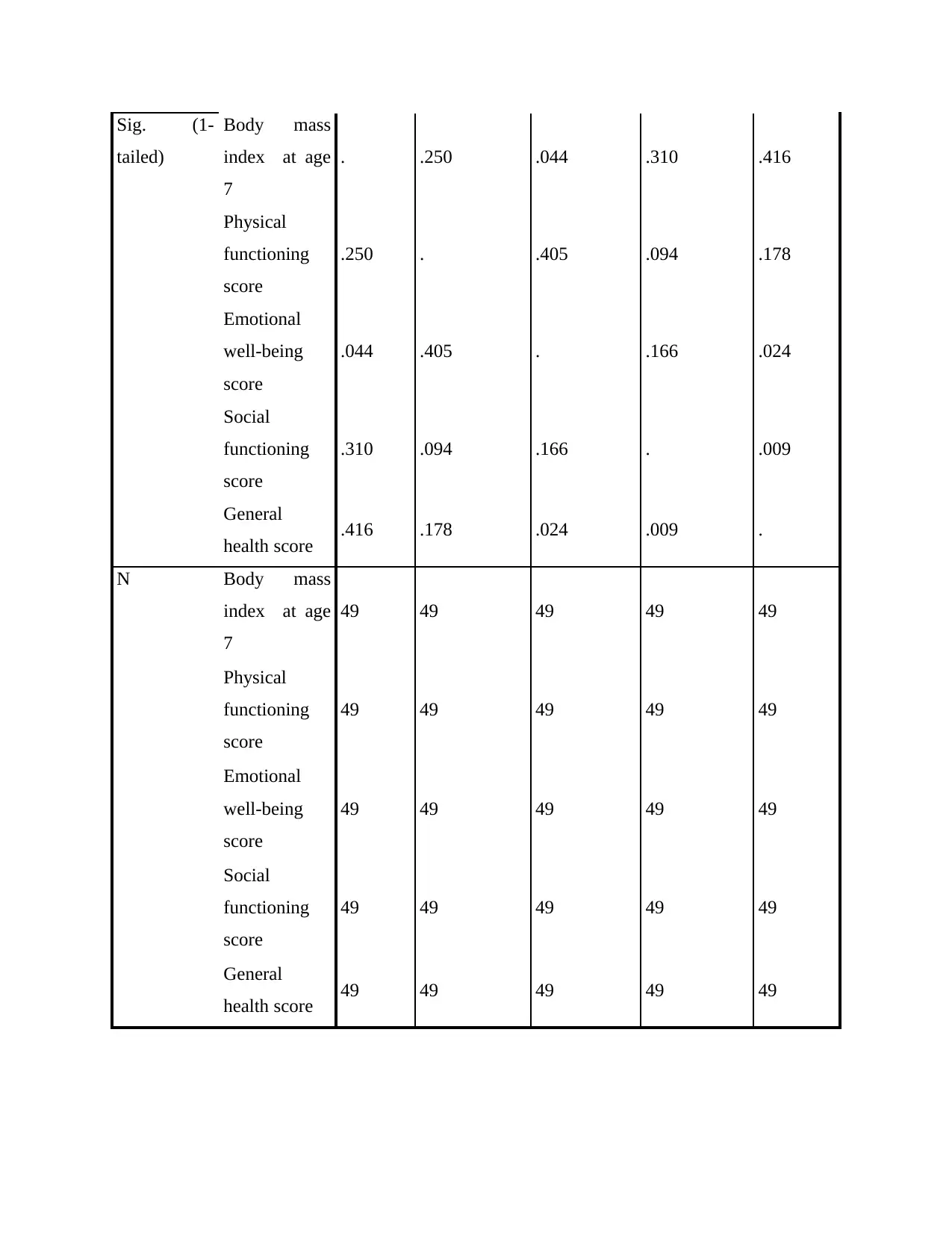
Sig. (1-
tailed)
Body mass
index at age
7
. .250 .044 .310 .416
Physical
functioning
score
.250 . .405 .094 .178
Emotional
well-being
score
.044 .405 . .166 .024
Social
functioning
score
.310 .094 .166 . .009
General
health score .416 .178 .024 .009 .
N Body mass
index at age
7
49 49 49 49 49
Physical
functioning
score
49 49 49 49 49
Emotional
well-being
score
49 49 49 49 49
Social
functioning
score
49 49 49 49 49
General
health score 49 49 49 49 49
tailed)
Body mass
index at age
7
. .250 .044 .310 .416
Physical
functioning
score
.250 . .405 .094 .178
Emotional
well-being
score
.044 .405 . .166 .024
Social
functioning
score
.310 .094 .166 . .009
General
health score .416 .178 .024 .009 .
N Body mass
index at age
7
49 49 49 49 49
Physical
functioning
score
49 49 49 49 49
Emotional
well-being
score
49 49 49 49 49
Social
functioning
score
49 49 49 49 49
General
health score 49 49 49 49 49
Secure Best Marks with AI Grader
Need help grading? Try our AI Grader for instant feedback on your assignments.
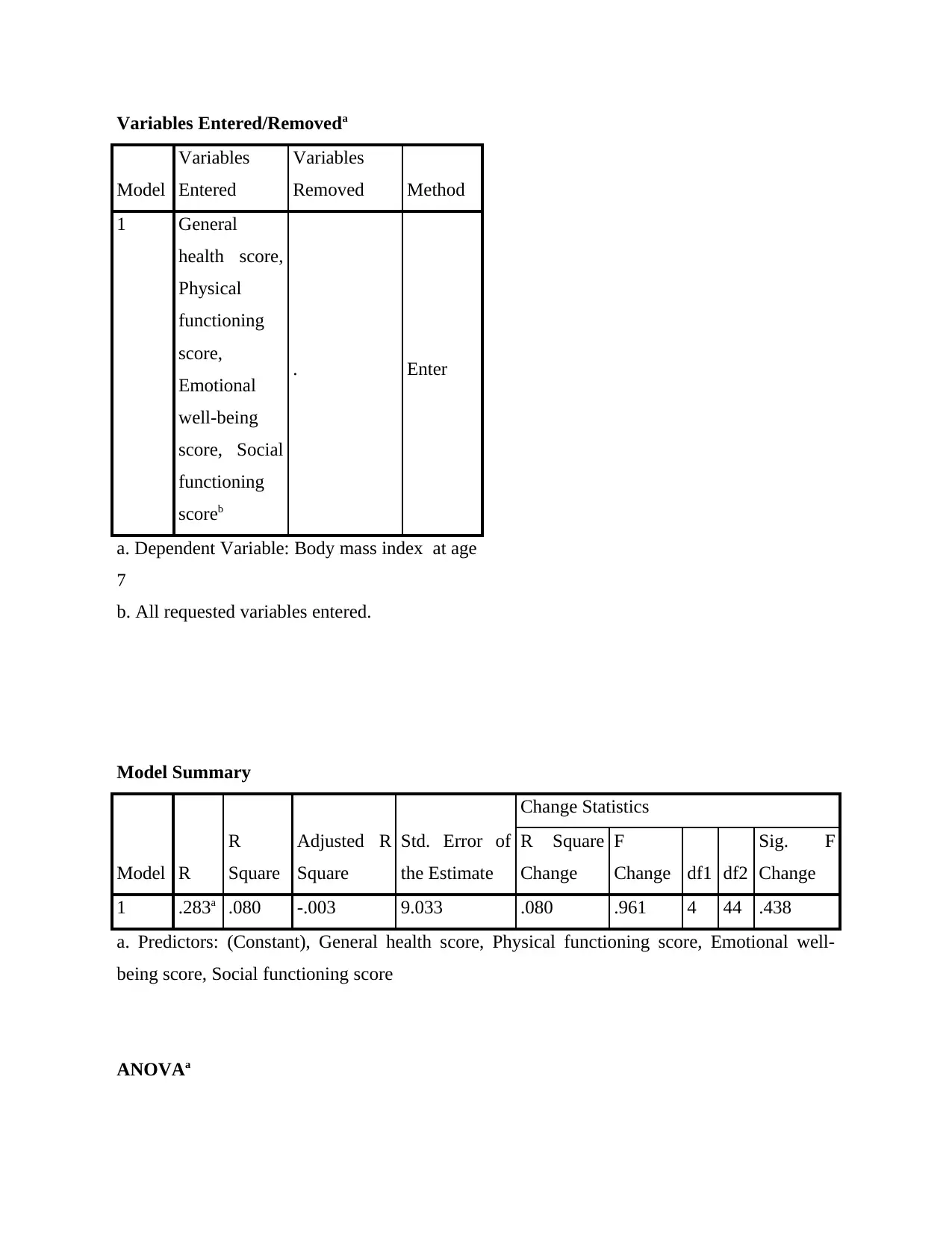
Variables Entered/Removeda
Model
Variables
Entered
Variables
Removed Method
1 General
health score,
Physical
functioning
score,
Emotional
well-being
score, Social
functioning
scoreb
. Enter
a. Dependent Variable: Body mass index at age
7
b. All requested variables entered.
Model Summary
Model R
R
Square
Adjusted R
Square
Std. Error of
the Estimate
Change Statistics
R Square
Change
F
Change df1 df2
Sig. F
Change
1 .283a .080 -.003 9.033 .080 .961 4 44 .438
a. Predictors: (Constant), General health score, Physical functioning score, Emotional well-
being score, Social functioning score
ANOVAa
Model
Variables
Entered
Variables
Removed Method
1 General
health score,
Physical
functioning
score,
Emotional
well-being
score, Social
functioning
scoreb
. Enter
a. Dependent Variable: Body mass index at age
7
b. All requested variables entered.
Model Summary
Model R
R
Square
Adjusted R
Square
Std. Error of
the Estimate
Change Statistics
R Square
Change
F
Change df1 df2
Sig. F
Change
1 .283a .080 -.003 9.033 .080 .961 4 44 .438
a. Predictors: (Constant), General health score, Physical functioning score, Emotional well-
being score, Social functioning score
ANOVAa
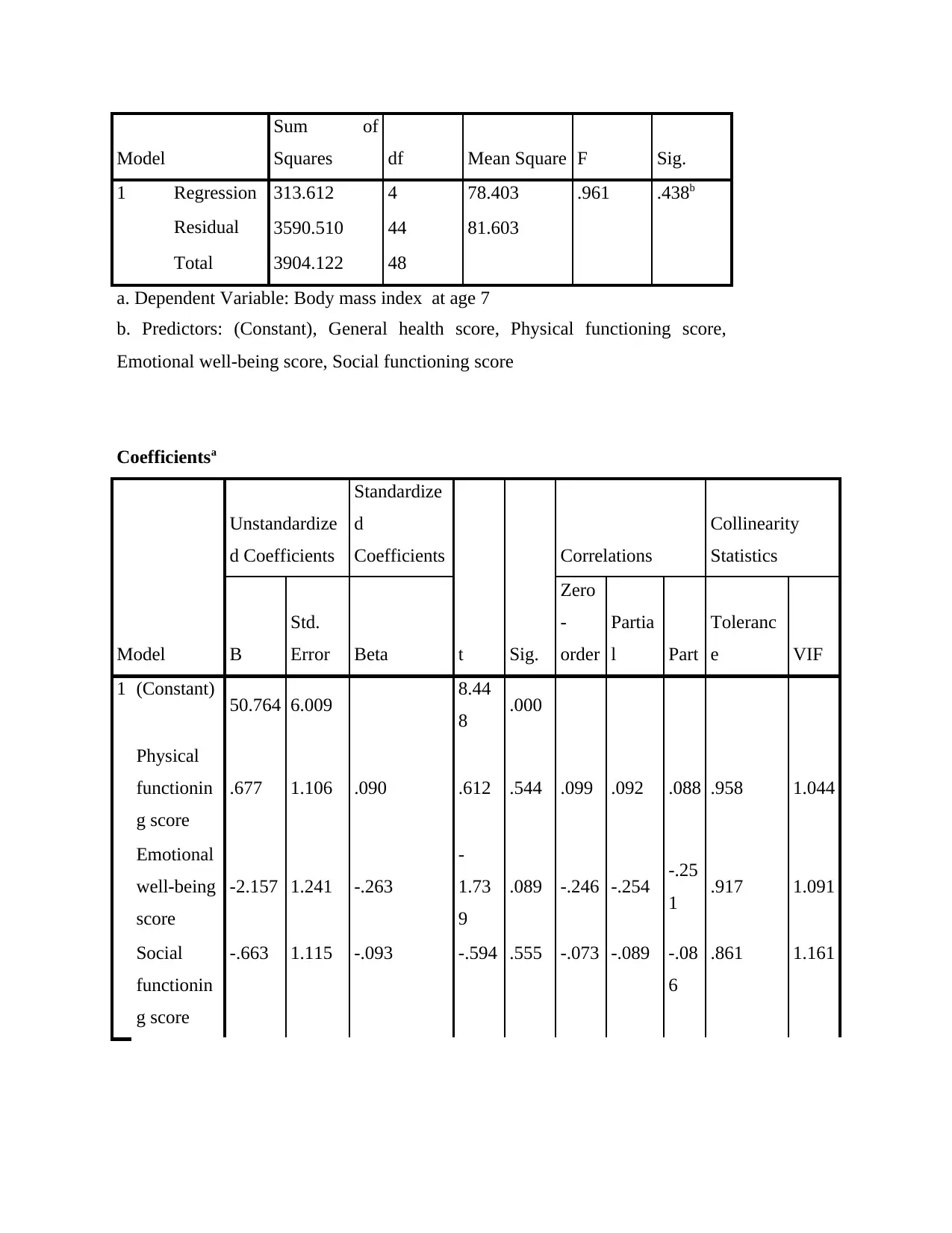
Model
Sum of
Squares df Mean Square F Sig.
1 Regression 313.612 4 78.403 .961 .438b
Residual 3590.510 44 81.603
Total 3904.122 48
a. Dependent Variable: Body mass index at age 7
b. Predictors: (Constant), General health score, Physical functioning score,
Emotional well-being score, Social functioning score
Coefficientsa
Model
Unstandardize
d Coefficients
Standardize
d
Coefficients
t Sig.
Correlations
Collinearity
Statistics
B
Std.
Error Beta
Zero
-
order
Partia
l Part
Toleranc
e VIF
1 (Constant) 50.764 6.009 8.44
8 .000
Physical
functionin
g score
.677 1.106 .090 .612 .544 .099 .092 .088 .958 1.044
Emotional
well-being
score
-2.157 1.241 -.263
-
1.73
9
.089 -.246 -.254 -.25
1 .917 1.091
Social
functionin
g score
-.663 1.115 -.093 -.594 .555 -.073 -.089 -.08
6
.861 1.161
Sum of
Squares df Mean Square F Sig.
1 Regression 313.612 4 78.403 .961 .438b
Residual 3590.510 44 81.603
Total 3904.122 48
a. Dependent Variable: Body mass index at age 7
b. Predictors: (Constant), General health score, Physical functioning score,
Emotional well-being score, Social functioning score
Coefficientsa
Model
Unstandardize
d Coefficients
Standardize
d
Coefficients
t Sig.
Correlations
Collinearity
Statistics
B
Std.
Error Beta
Zero
-
order
Partia
l Part
Toleranc
e VIF
1 (Constant) 50.764 6.009 8.44
8 .000
Physical
functionin
g score
.677 1.106 .090 .612 .544 .099 .092 .088 .958 1.044
Emotional
well-being
score
-2.157 1.241 -.263
-
1.73
9
.089 -.246 -.254 -.25
1 .917 1.091
Social
functionin
g score
-.663 1.115 -.093 -.594 .555 -.073 -.089 -.08
6
.861 1.161
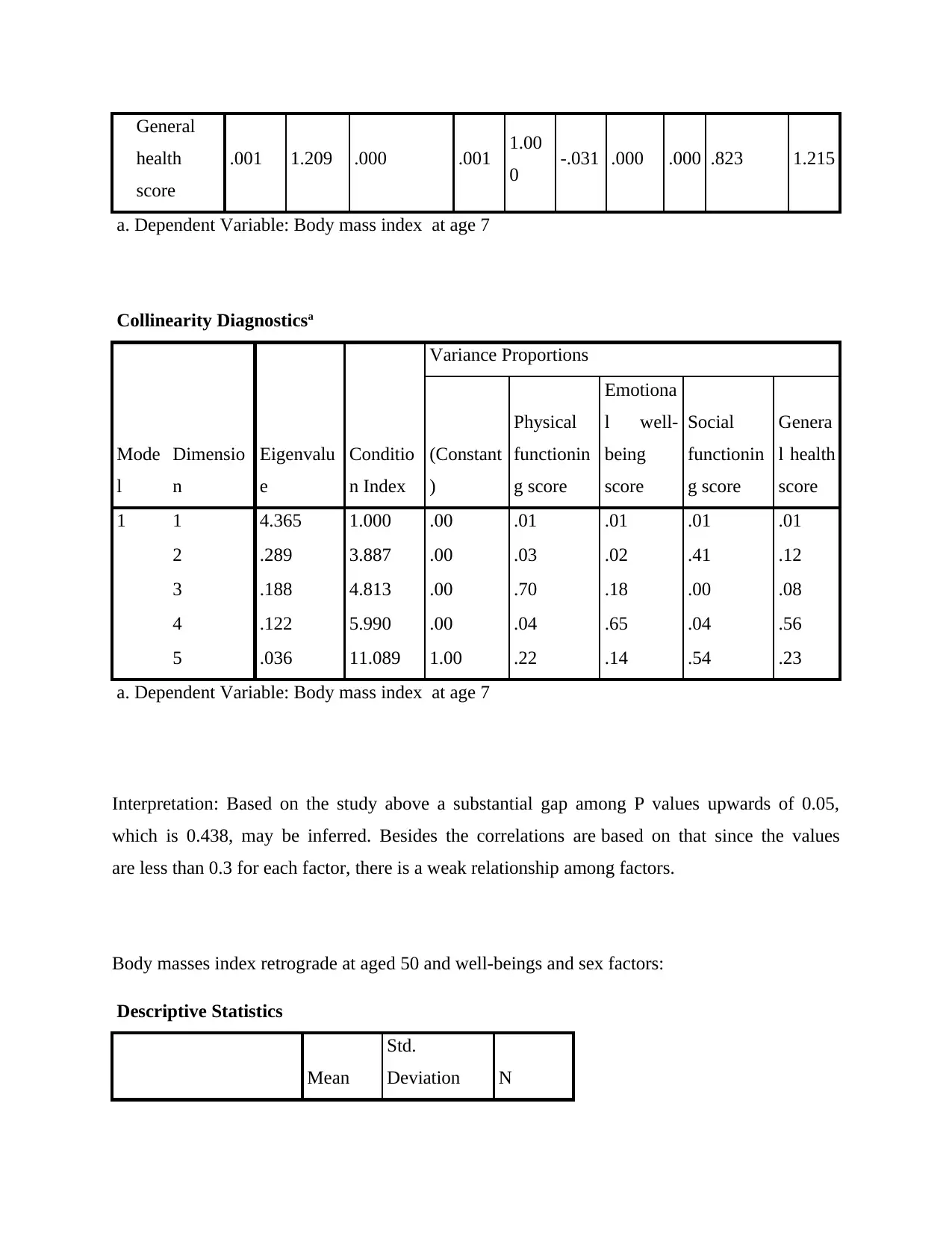
General
health
score
.001 1.209 .000 .001 1.00
0 -.031 .000 .000 .823 1.215
a. Dependent Variable: Body mass index at age 7
Collinearity Diagnosticsa
Mode
l
Dimensio
n
Eigenvalu
e
Conditio
n Index
Variance Proportions
(Constant
)
Physical
functionin
g score
Emotiona
l well-
being
score
Social
functionin
g score
Genera
l health
score
1 1 4.365 1.000 .00 .01 .01 .01 .01
2 .289 3.887 .00 .03 .02 .41 .12
3 .188 4.813 .00 .70 .18 .00 .08
4 .122 5.990 .00 .04 .65 .04 .56
5 .036 11.089 1.00 .22 .14 .54 .23
a. Dependent Variable: Body mass index at age 7
Interpretation: Based on the study above a substantial gap among P values upwards of 0.05,
which is 0.438, may be inferred. Besides the correlations are based on that since the values
are less than 0.3 for each factor, there is a weak relationship among factors.
Body masses index retrograde at aged 50 and well-beings and sex factors:
Descriptive Statistics
Mean
Std.
Deviation N
health
score
.001 1.209 .000 .001 1.00
0 -.031 .000 .000 .823 1.215
a. Dependent Variable: Body mass index at age 7
Collinearity Diagnosticsa
Mode
l
Dimensio
n
Eigenvalu
e
Conditio
n Index
Variance Proportions
(Constant
)
Physical
functionin
g score
Emotiona
l well-
being
score
Social
functionin
g score
Genera
l health
score
1 1 4.365 1.000 .00 .01 .01 .01 .01
2 .289 3.887 .00 .03 .02 .41 .12
3 .188 4.813 .00 .70 .18 .00 .08
4 .122 5.990 .00 .04 .65 .04 .56
5 .036 11.089 1.00 .22 .14 .54 .23
a. Dependent Variable: Body mass index at age 7
Interpretation: Based on the study above a substantial gap among P values upwards of 0.05,
which is 0.438, may be inferred. Besides the correlations are based on that since the values
are less than 0.3 for each factor, there is a weak relationship among factors.
Body masses index retrograde at aged 50 and well-beings and sex factors:
Descriptive Statistics
Mean
Std.
Deviation N
Paraphrase This Document
Need a fresh take? Get an instant paraphrase of this document with our AI Paraphraser
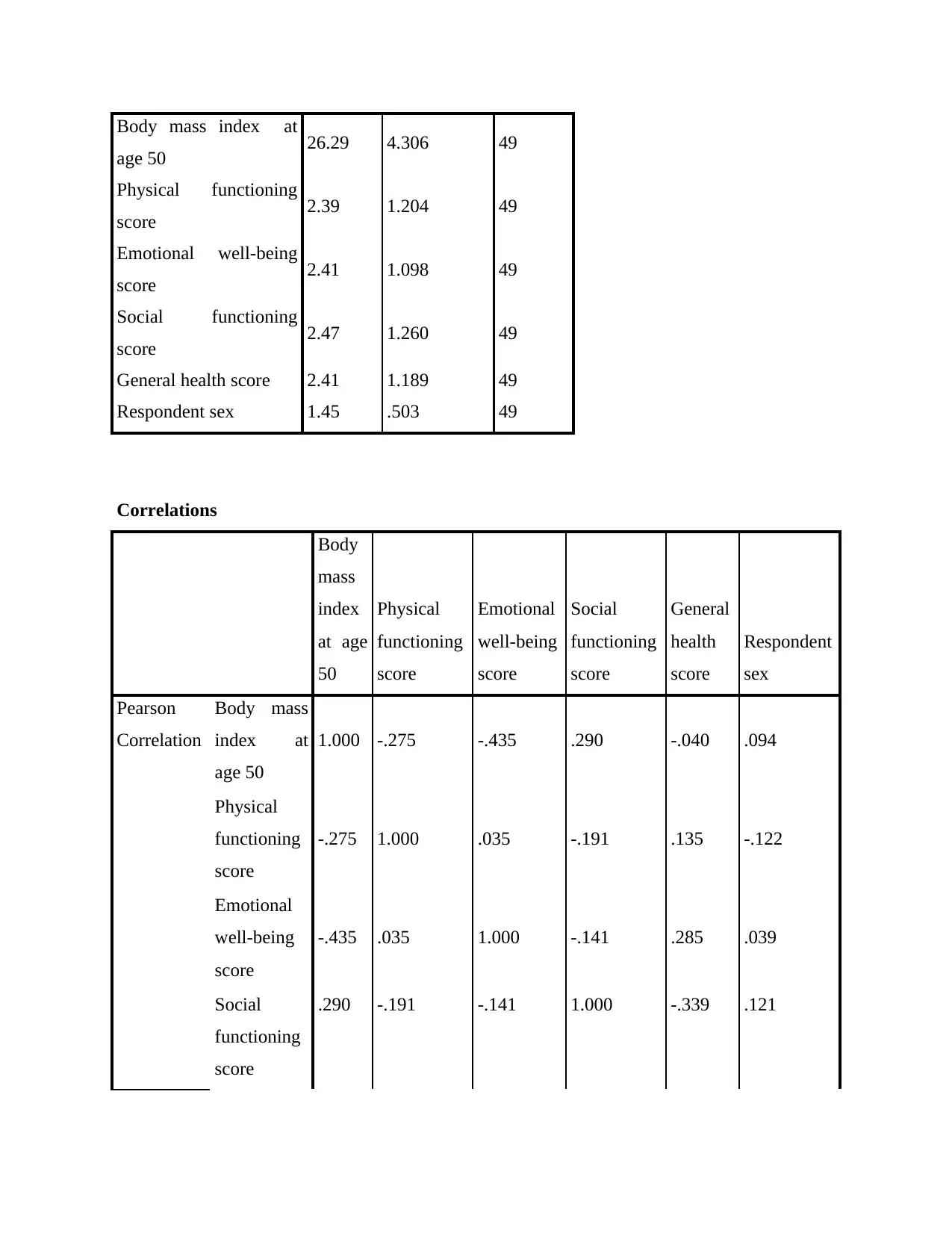
Body mass index at
age 50 26.29 4.306 49
Physical functioning
score 2.39 1.204 49
Emotional well-being
score 2.41 1.098 49
Social functioning
score 2.47 1.260 49
General health score 2.41 1.189 49
Respondent sex 1.45 .503 49
Correlations
Body
mass
index
at age
50
Physical
functioning
score
Emotional
well-being
score
Social
functioning
score
General
health
score
Respondent
sex
Pearson
Correlation
Body mass
index at
age 50
1.000 -.275 -.435 .290 -.040 .094
Physical
functioning
score
-.275 1.000 .035 -.191 .135 -.122
Emotional
well-being
score
-.435 .035 1.000 -.141 .285 .039
Social
functioning
score
.290 -.191 -.141 1.000 -.339 .121
age 50 26.29 4.306 49
Physical functioning
score 2.39 1.204 49
Emotional well-being
score 2.41 1.098 49
Social functioning
score 2.47 1.260 49
General health score 2.41 1.189 49
Respondent sex 1.45 .503 49
Correlations
Body
mass
index
at age
50
Physical
functioning
score
Emotional
well-being
score
Social
functioning
score
General
health
score
Respondent
sex
Pearson
Correlation
Body mass
index at
age 50
1.000 -.275 -.435 .290 -.040 .094
Physical
functioning
score
-.275 1.000 .035 -.191 .135 -.122
Emotional
well-being
score
-.435 .035 1.000 -.141 .285 .039
Social
functioning
score
.290 -.191 -.141 1.000 -.339 .121
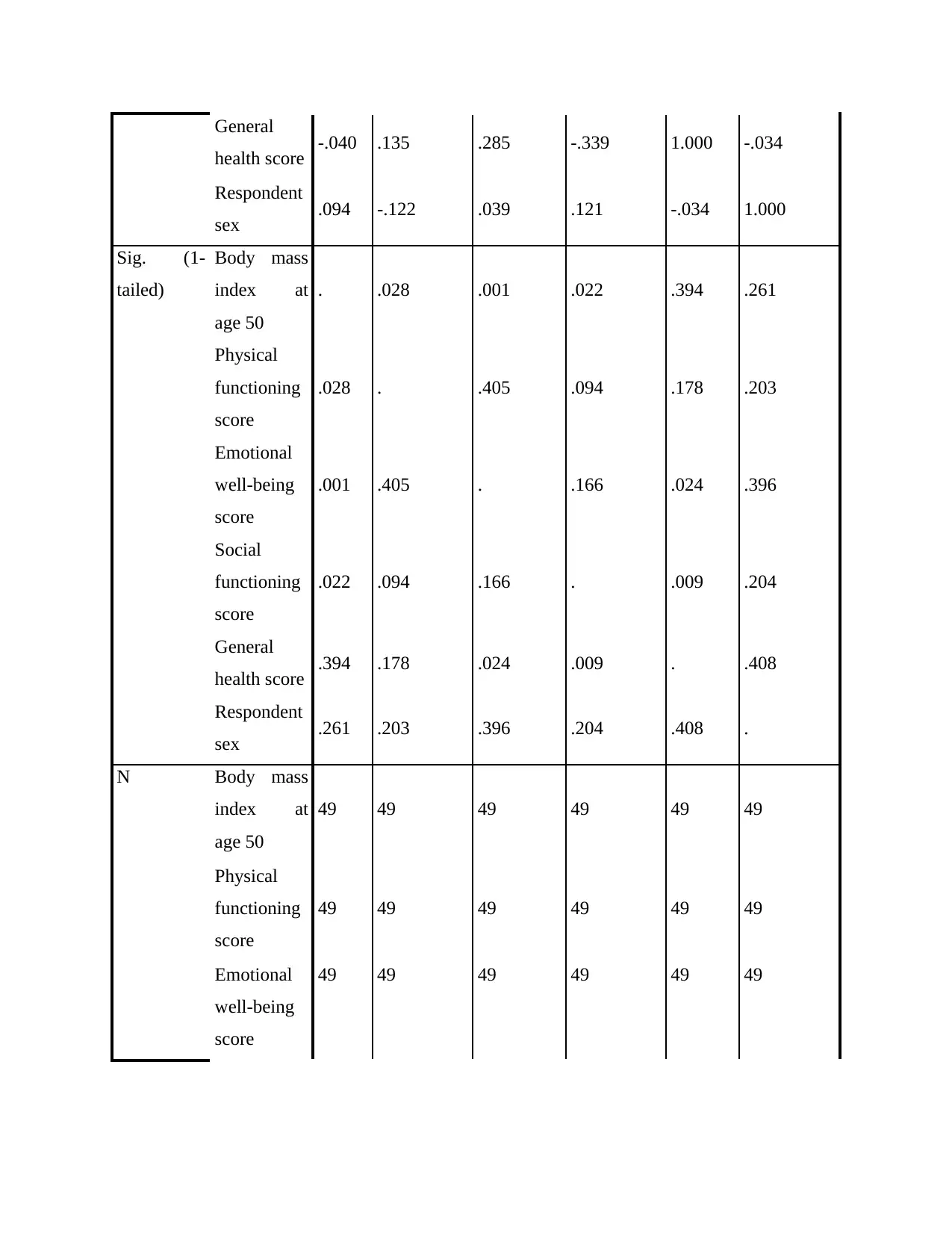
General
health score -.040 .135 .285 -.339 1.000 -.034
Respondent
sex .094 -.122 .039 .121 -.034 1.000
Sig. (1-
tailed)
Body mass
index at
age 50
. .028 .001 .022 .394 .261
Physical
functioning
score
.028 . .405 .094 .178 .203
Emotional
well-being
score
.001 .405 . .166 .024 .396
Social
functioning
score
.022 .094 .166 . .009 .204
General
health score .394 .178 .024 .009 . .408
Respondent
sex .261 .203 .396 .204 .408 .
N Body mass
index at
age 50
49 49 49 49 49 49
Physical
functioning
score
49 49 49 49 49 49
Emotional
well-being
score
49 49 49 49 49 49
health score -.040 .135 .285 -.339 1.000 -.034
Respondent
sex .094 -.122 .039 .121 -.034 1.000
Sig. (1-
tailed)
Body mass
index at
age 50
. .028 .001 .022 .394 .261
Physical
functioning
score
.028 . .405 .094 .178 .203
Emotional
well-being
score
.001 .405 . .166 .024 .396
Social
functioning
score
.022 .094 .166 . .009 .204
General
health score .394 .178 .024 .009 . .408
Respondent
sex .261 .203 .396 .204 .408 .
N Body mass
index at
age 50
49 49 49 49 49 49
Physical
functioning
score
49 49 49 49 49 49
Emotional
well-being
score
49 49 49 49 49 49
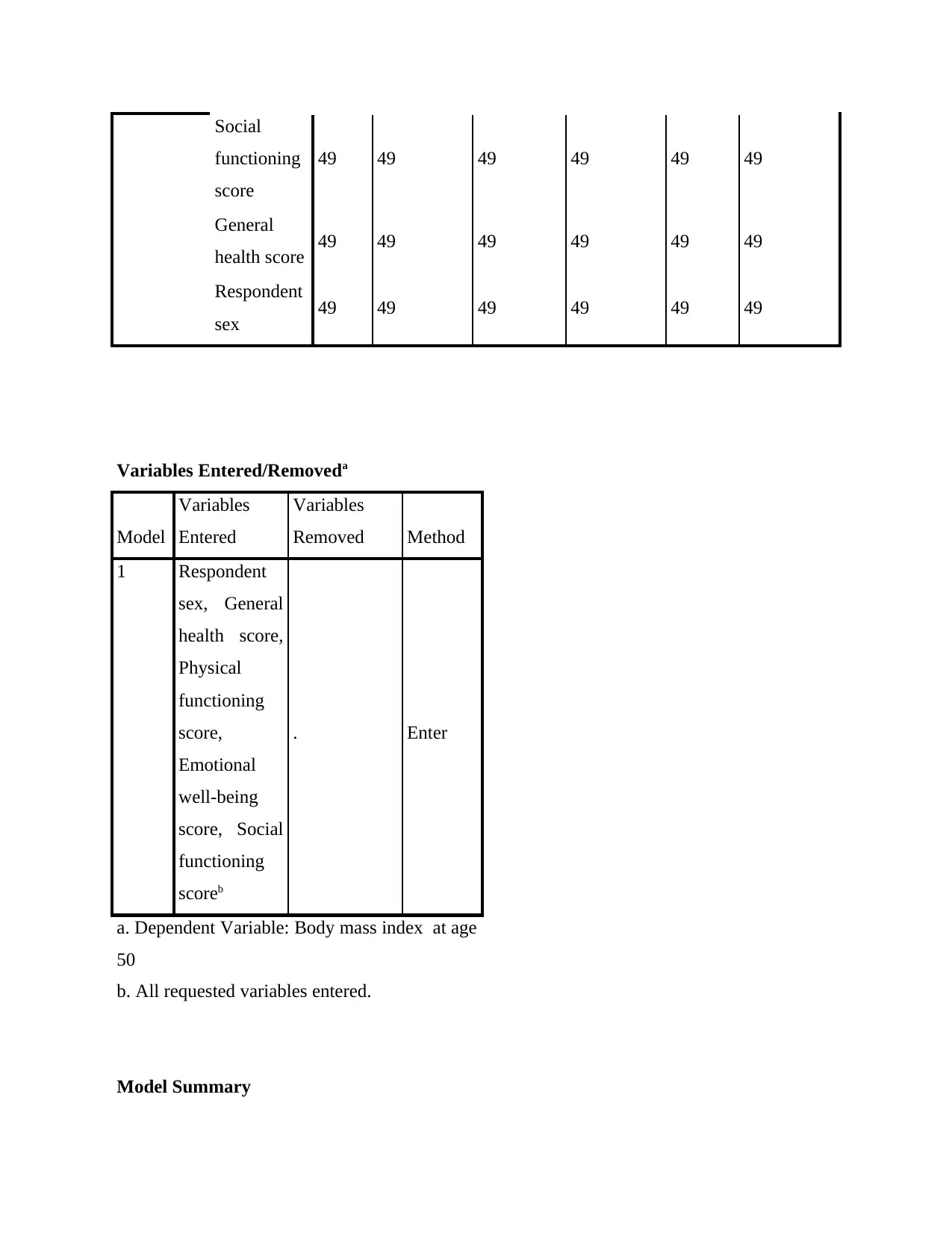
Social
functioning
score
49 49 49 49 49 49
General
health score 49 49 49 49 49 49
Respondent
sex 49 49 49 49 49 49
Variables Entered/Removeda
Model
Variables
Entered
Variables
Removed Method
1 Respondent
sex, General
health score,
Physical
functioning
score,
Emotional
well-being
score, Social
functioning
scoreb
. Enter
a. Dependent Variable: Body mass index at age
50
b. All requested variables entered.
Model Summary
functioning
score
49 49 49 49 49 49
General
health score 49 49 49 49 49 49
Respondent
sex 49 49 49 49 49 49
Variables Entered/Removeda
Model
Variables
Entered
Variables
Removed Method
1 Respondent
sex, General
health score,
Physical
functioning
score,
Emotional
well-being
score, Social
functioning
scoreb
. Enter
a. Dependent Variable: Body mass index at age
50
b. All requested variables entered.
Model Summary
Secure Best Marks with AI Grader
Need help grading? Try our AI Grader for instant feedback on your assignments.
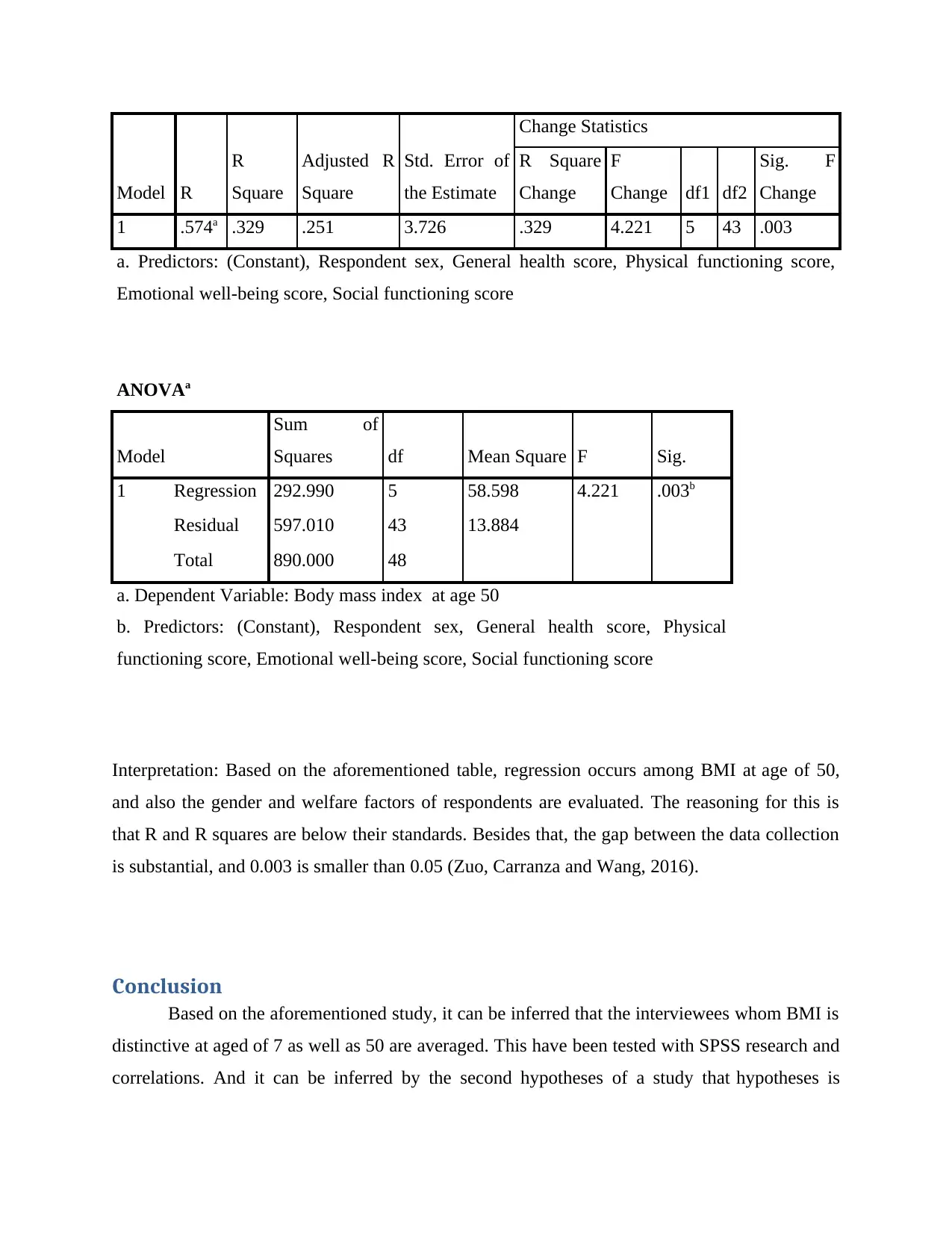
Model R
R
Square
Adjusted R
Square
Std. Error of
the Estimate
Change Statistics
R Square
Change
F
Change df1 df2
Sig. F
Change
1 .574a .329 .251 3.726 .329 4.221 5 43 .003
a. Predictors: (Constant), Respondent sex, General health score, Physical functioning score,
Emotional well-being score, Social functioning score
ANOVAa
Model
Sum of
Squares df Mean Square F Sig.
1 Regression 292.990 5 58.598 4.221 .003b
Residual 597.010 43 13.884
Total 890.000 48
a. Dependent Variable: Body mass index at age 50
b. Predictors: (Constant), Respondent sex, General health score, Physical
functioning score, Emotional well-being score, Social functioning score
Interpretation: Based on the aforementioned table, regression occurs among BMI at age of 50,
and also the gender and welfare factors of respondents are evaluated. The reasoning for this is
that R and R squares are below their standards. Besides that, the gap between the data collection
is substantial, and 0.003 is smaller than 0.05 (Zuo, Carranza and Wang, 2016).
Conclusion
Based on the aforementioned study, it can be inferred that the interviewees whom BMI is
distinctive at aged of 7 as well as 50 are averaged. This have been tested with SPSS research and
correlations. And it can be inferred by the second hypotheses of a study that hypotheses is
R
Square
Adjusted R
Square
Std. Error of
the Estimate
Change Statistics
R Square
Change
F
Change df1 df2
Sig. F
Change
1 .574a .329 .251 3.726 .329 4.221 5 43 .003
a. Predictors: (Constant), Respondent sex, General health score, Physical functioning score,
Emotional well-being score, Social functioning score
ANOVAa
Model
Sum of
Squares df Mean Square F Sig.
1 Regression 292.990 5 58.598 4.221 .003b
Residual 597.010 43 13.884
Total 890.000 48
a. Dependent Variable: Body mass index at age 50
b. Predictors: (Constant), Respondent sex, General health score, Physical
functioning score, Emotional well-being score, Social functioning score
Interpretation: Based on the aforementioned table, regression occurs among BMI at age of 50,
and also the gender and welfare factors of respondents are evaluated. The reasoning for this is
that R and R squares are below their standards. Besides that, the gap between the data collection
is substantial, and 0.003 is smaller than 0.05 (Zuo, Carranza and Wang, 2016).
Conclusion
Based on the aforementioned study, it can be inferred that the interviewees whom BMI is
distinctive at aged of 7 as well as 50 are averaged. This have been tested with SPSS research and
correlations. And it can be inferred by the second hypotheses of a study that hypotheses is
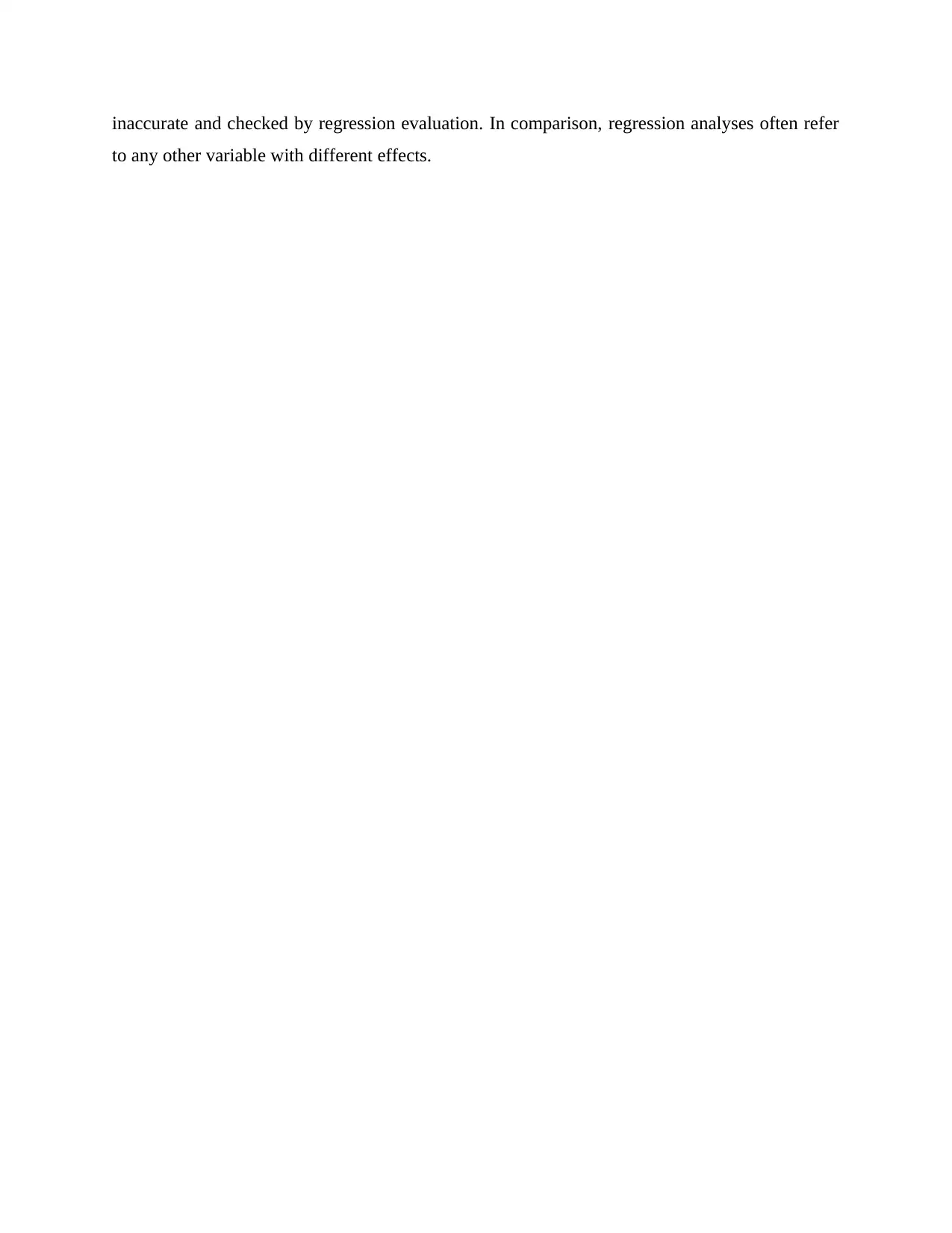
inaccurate and checked by regression evaluation. In comparison, regression analyses often refer
to any other variable with different effects.
to any other variable with different effects.
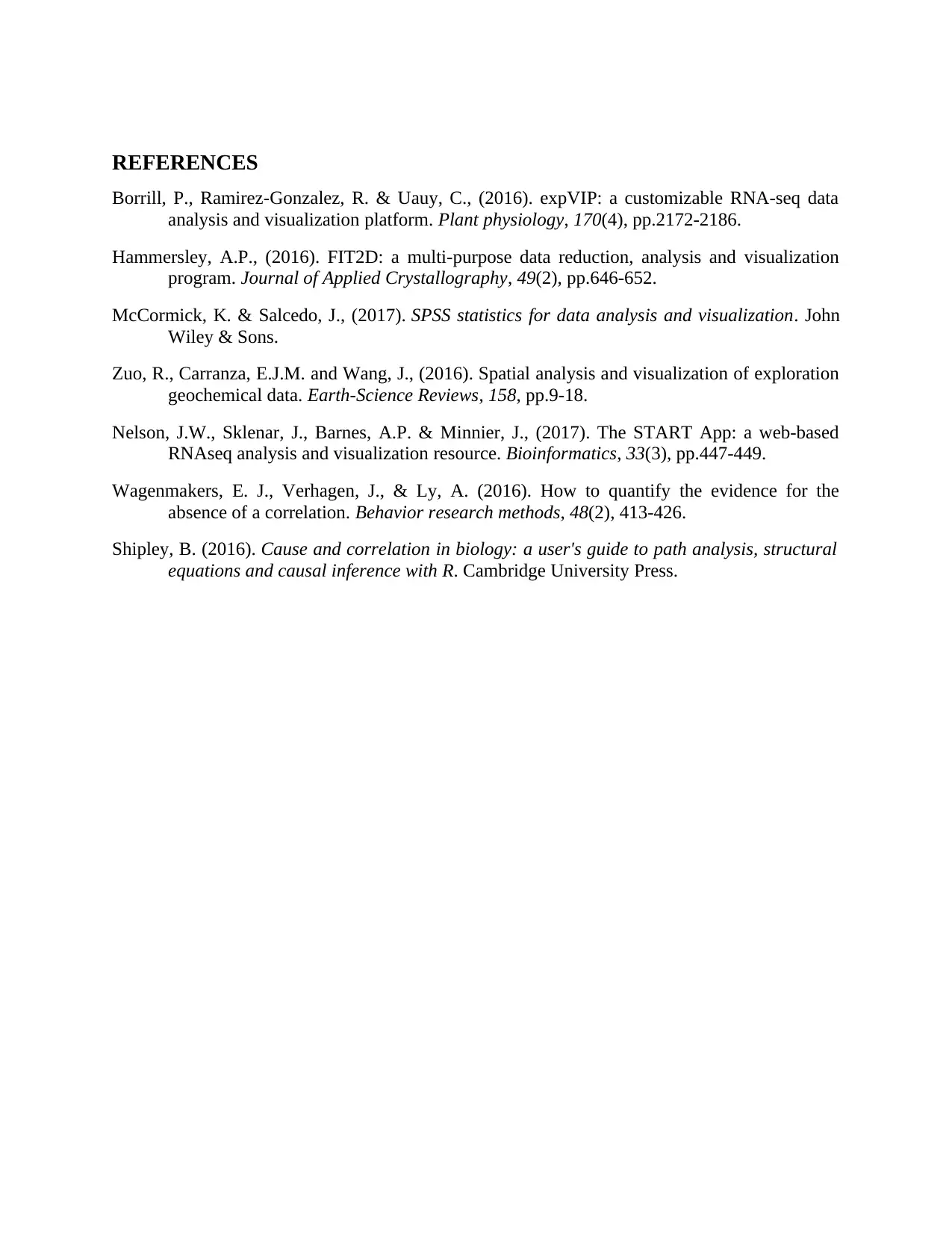
REFERENCES
Borrill, P., Ramirez-Gonzalez, R. & Uauy, C., (2016). expVIP: a customizable RNA-seq data
analysis and visualization platform. Plant physiology, 170(4), pp.2172-2186.
Hammersley, A.P., (2016). FIT2D: a multi-purpose data reduction, analysis and visualization
program. Journal of Applied Crystallography, 49(2), pp.646-652.
McCormick, K. & Salcedo, J., (2017). SPSS statistics for data analysis and visualization. John
Wiley & Sons.
Zuo, R., Carranza, E.J.M. and Wang, J., (2016). Spatial analysis and visualization of exploration
geochemical data. Earth-Science Reviews, 158, pp.9-18.
Nelson, J.W., Sklenar, J., Barnes, A.P. & Minnier, J., (2017). The START App: a web-based
RNAseq analysis and visualization resource. Bioinformatics, 33(3), pp.447-449.
Wagenmakers, E. J., Verhagen, J., & Ly, A. (2016). How to quantify the evidence for the
absence of a correlation. Behavior research methods, 48(2), 413-426.
Shipley, B. (2016). Cause and correlation in biology: a user's guide to path analysis, structural
equations and causal inference with R. Cambridge University Press.
Borrill, P., Ramirez-Gonzalez, R. & Uauy, C., (2016). expVIP: a customizable RNA-seq data
analysis and visualization platform. Plant physiology, 170(4), pp.2172-2186.
Hammersley, A.P., (2016). FIT2D: a multi-purpose data reduction, analysis and visualization
program. Journal of Applied Crystallography, 49(2), pp.646-652.
McCormick, K. & Salcedo, J., (2017). SPSS statistics for data analysis and visualization. John
Wiley & Sons.
Zuo, R., Carranza, E.J.M. and Wang, J., (2016). Spatial analysis and visualization of exploration
geochemical data. Earth-Science Reviews, 158, pp.9-18.
Nelson, J.W., Sklenar, J., Barnes, A.P. & Minnier, J., (2017). The START App: a web-based
RNAseq analysis and visualization resource. Bioinformatics, 33(3), pp.447-449.
Wagenmakers, E. J., Verhagen, J., & Ly, A. (2016). How to quantify the evidence for the
absence of a correlation. Behavior research methods, 48(2), 413-426.
Shipley, B. (2016). Cause and correlation in biology: a user's guide to path analysis, structural
equations and causal inference with R. Cambridge University Press.
Paraphrase This Document
Need a fresh take? Get an instant paraphrase of this document with our AI Paraphraser
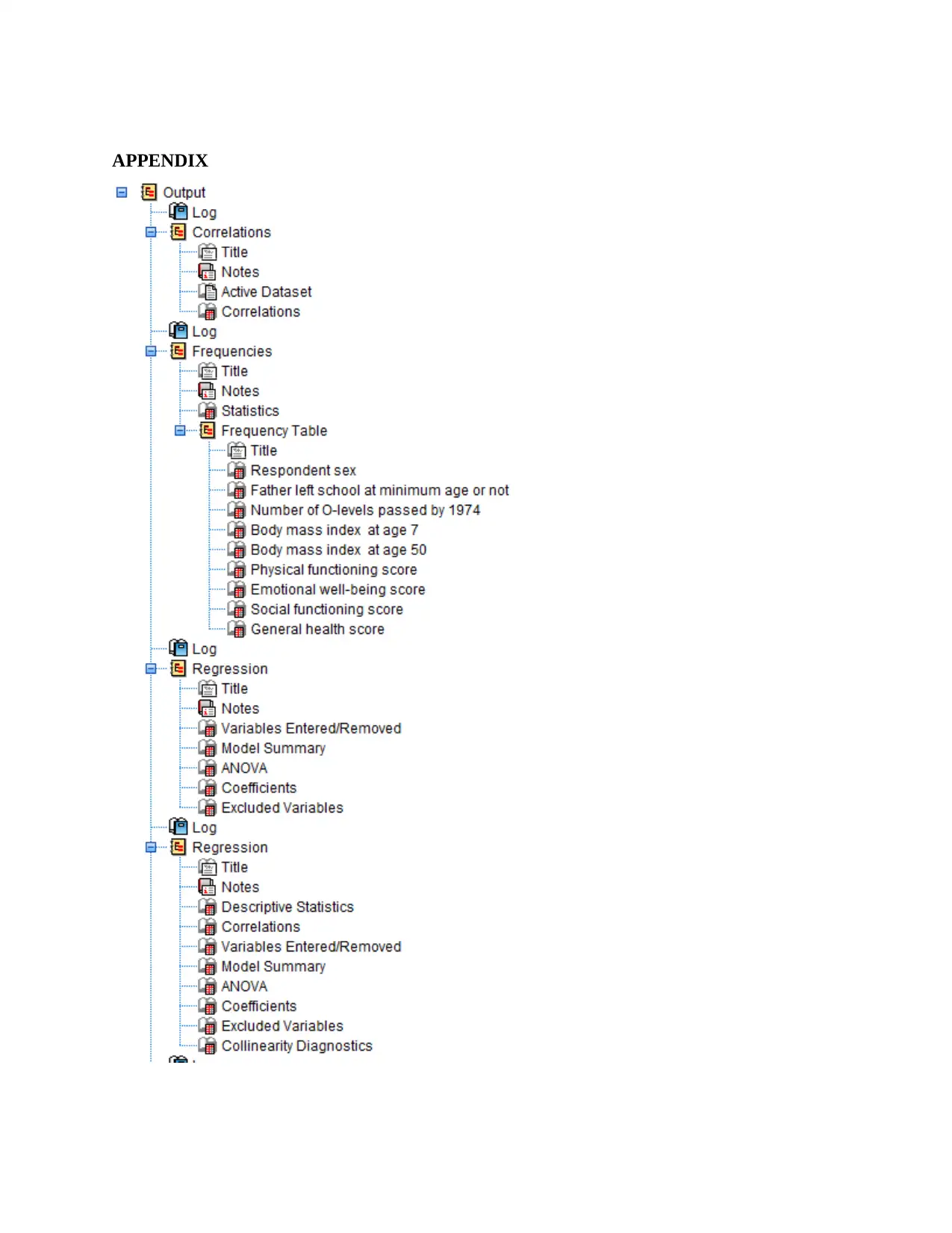
APPENDIX
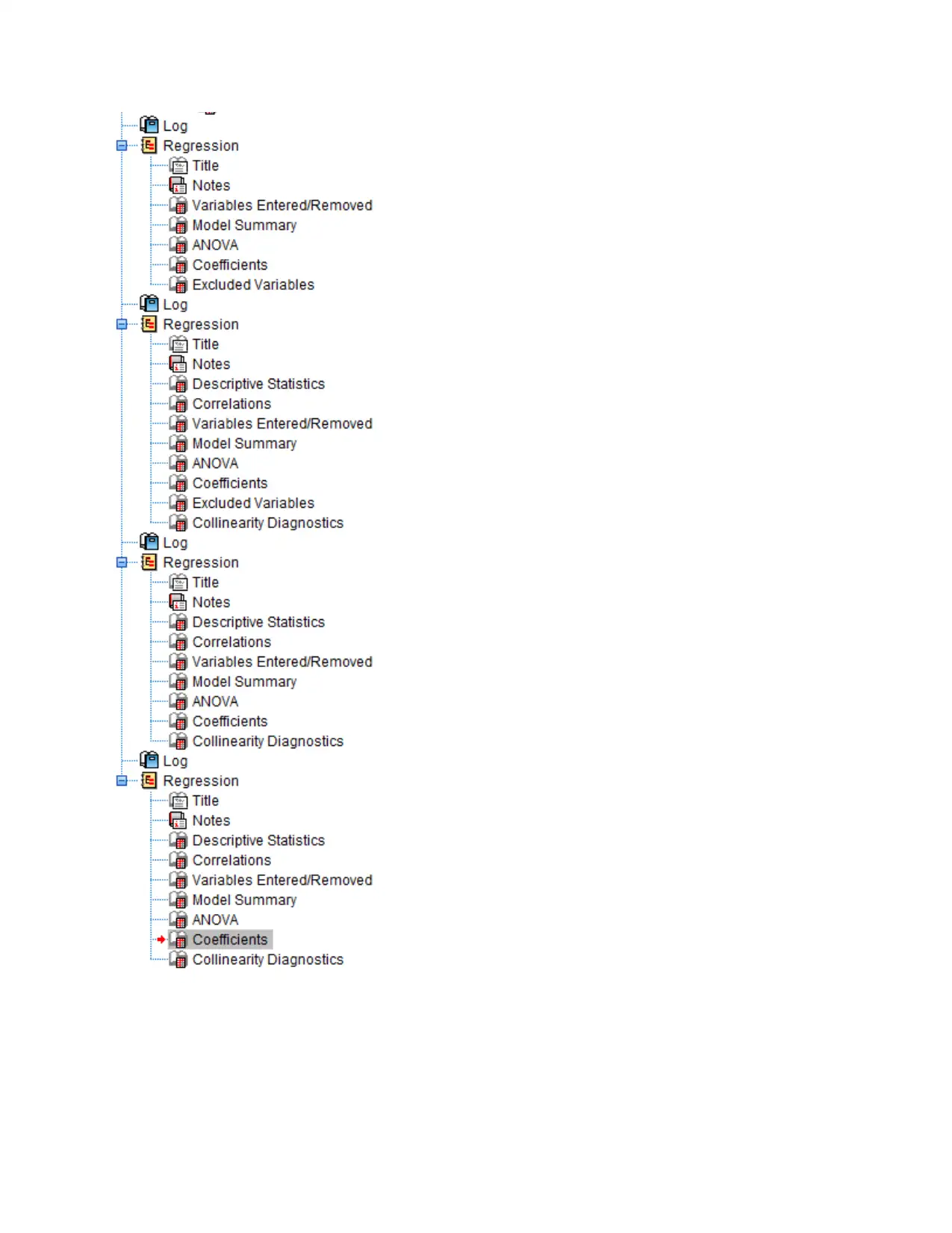
1 out of 27
Your All-in-One AI-Powered Toolkit for Academic Success.
+13062052269
info@desklib.com
Available 24*7 on WhatsApp / Email
![[object Object]](/_next/static/media/star-bottom.7253800d.svg)
Unlock your academic potential
© 2024 | Zucol Services PVT LTD | All rights reserved.

